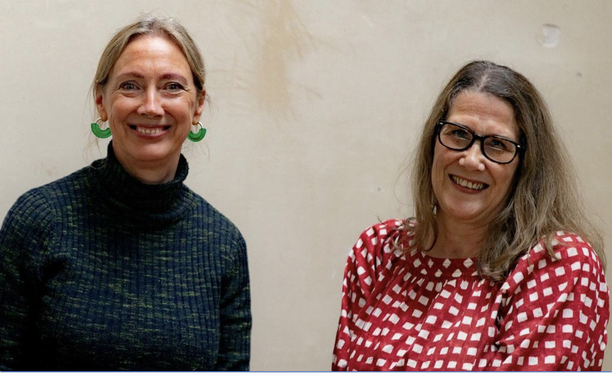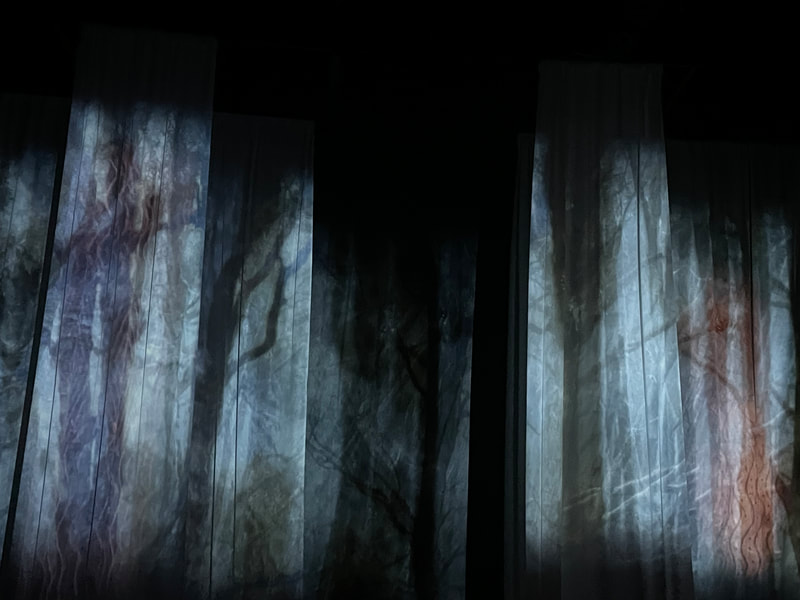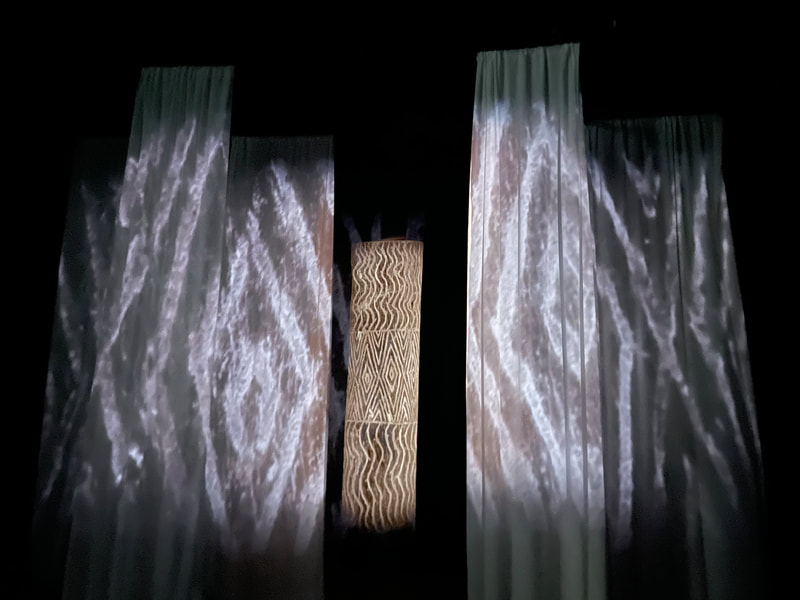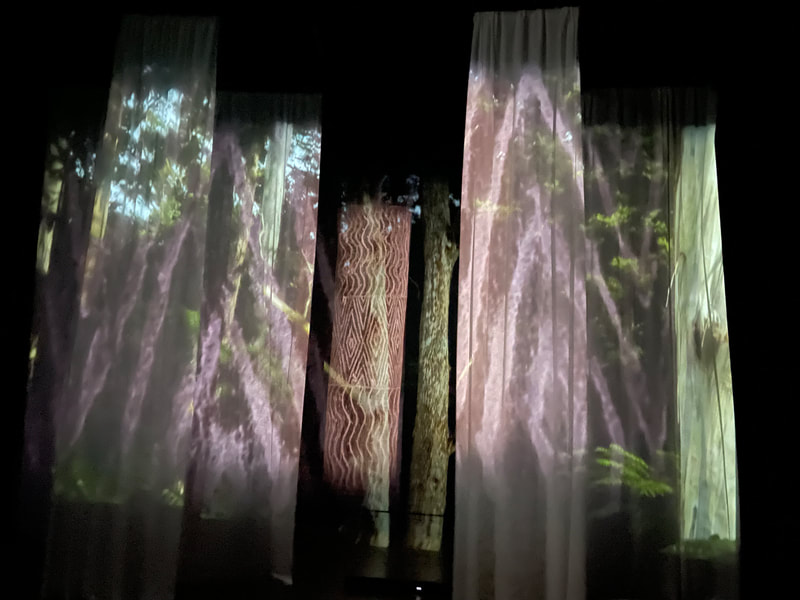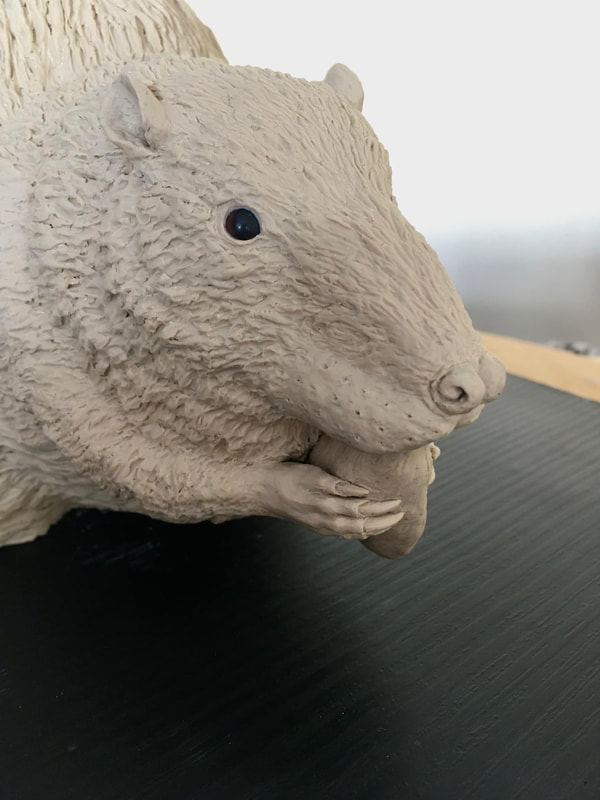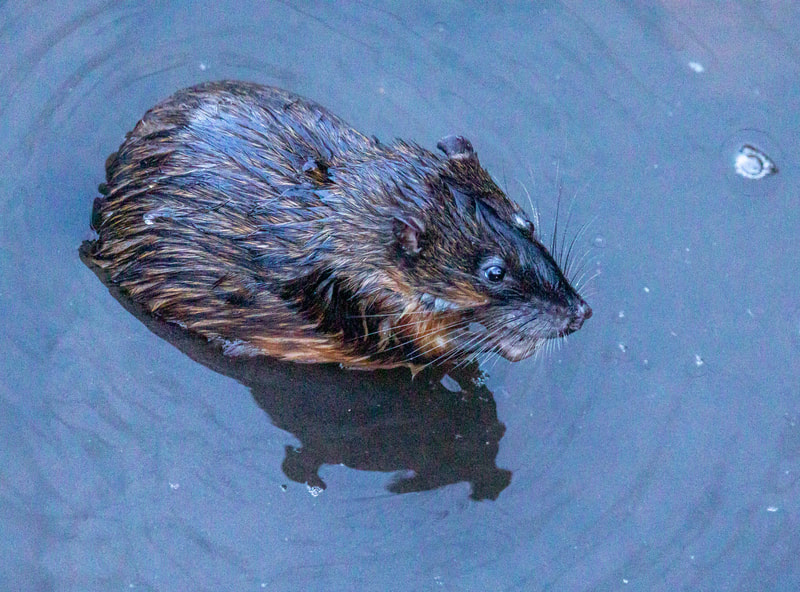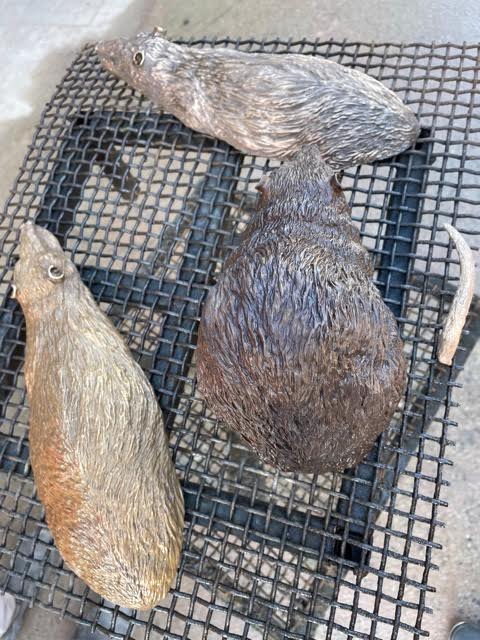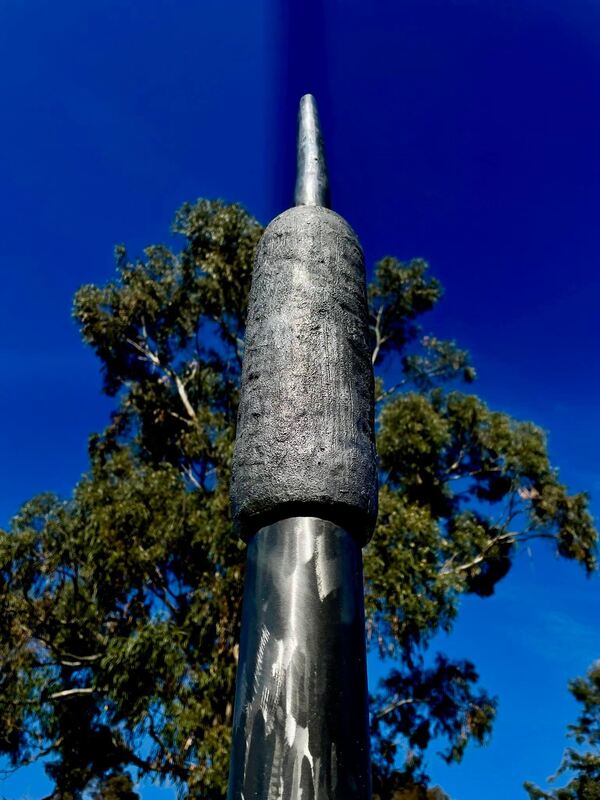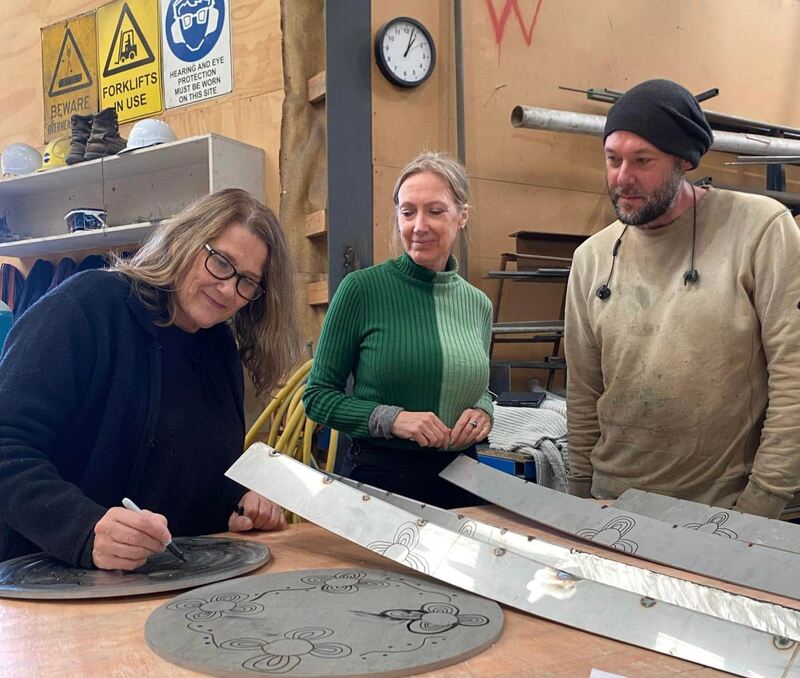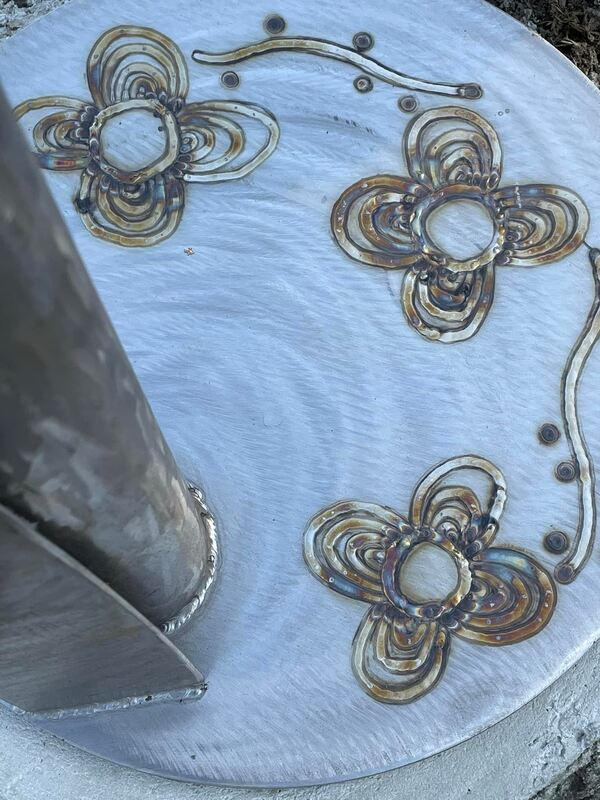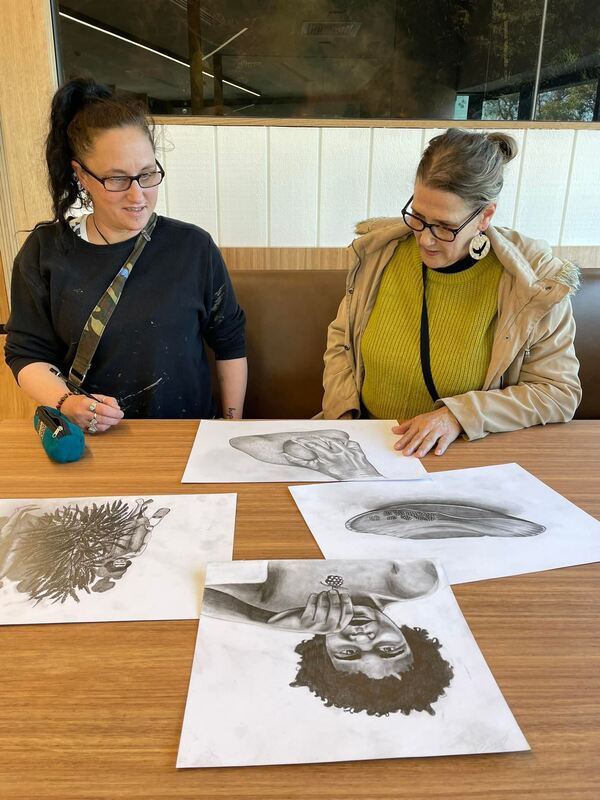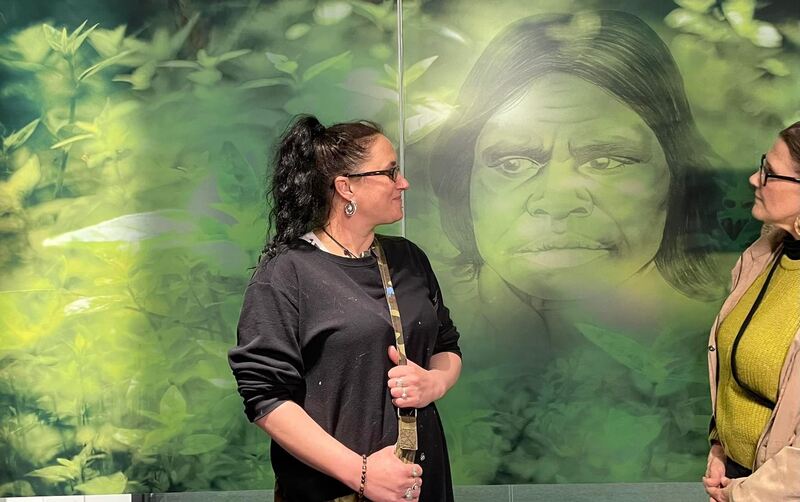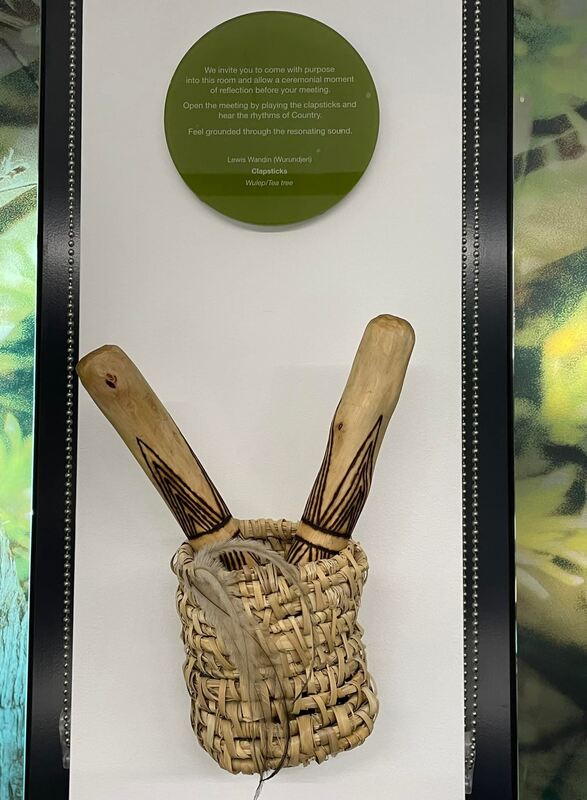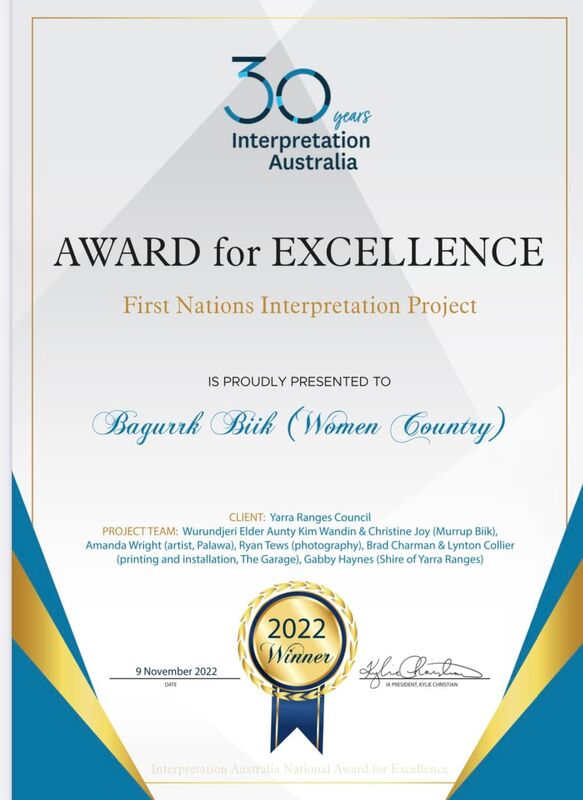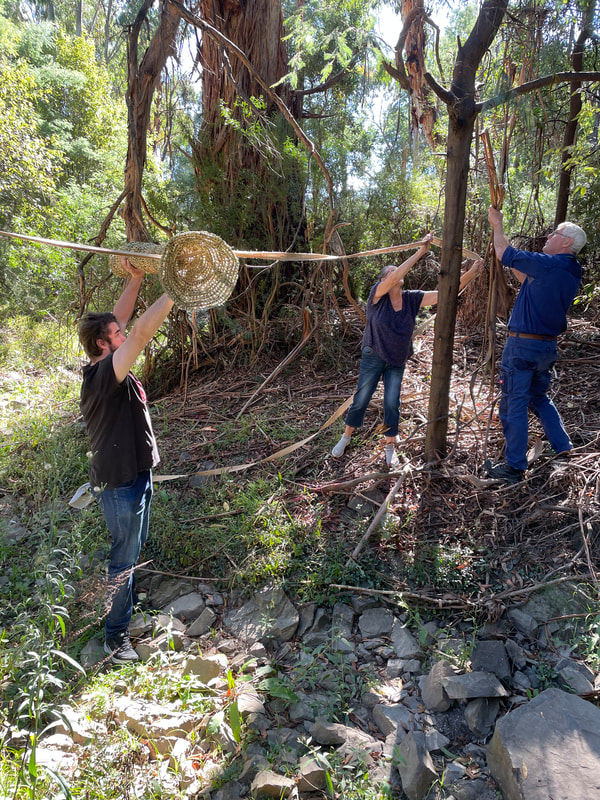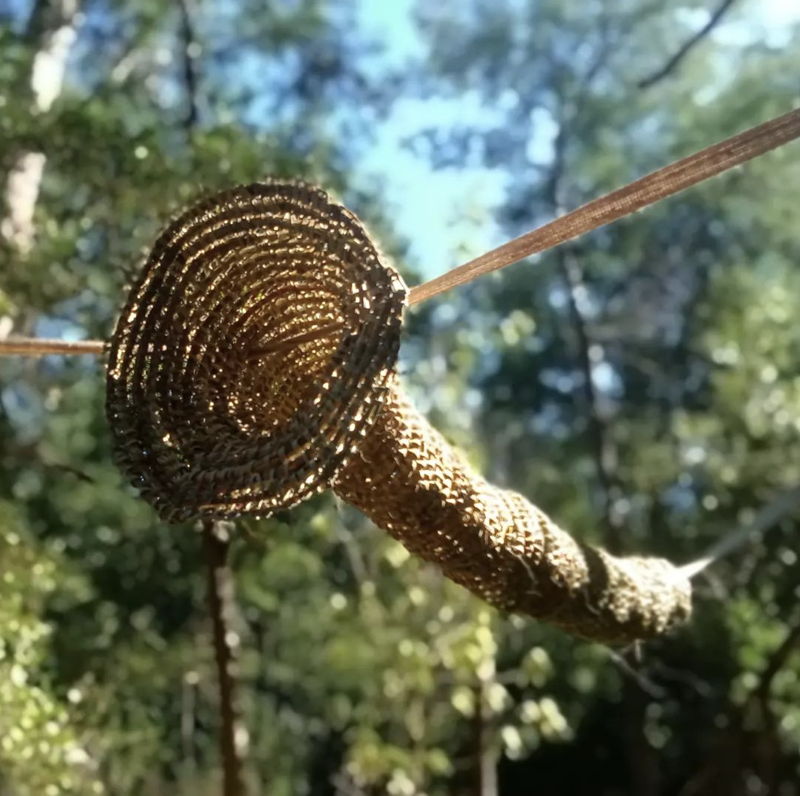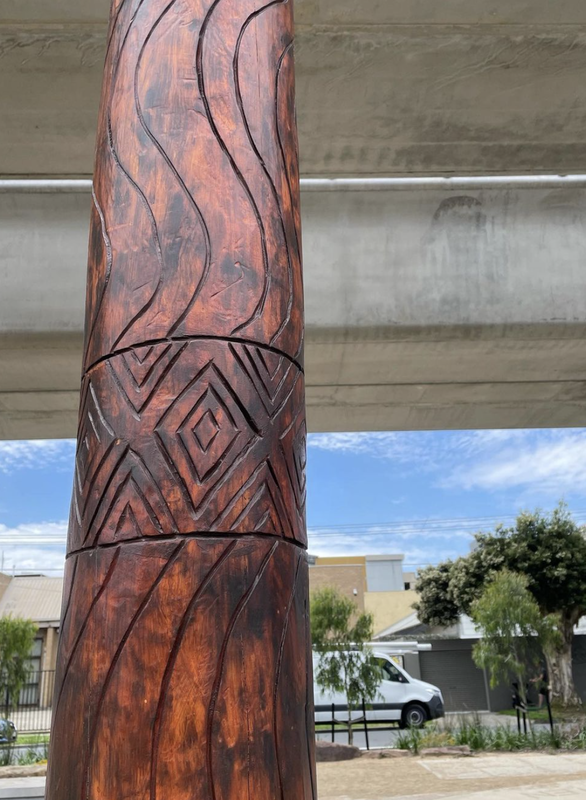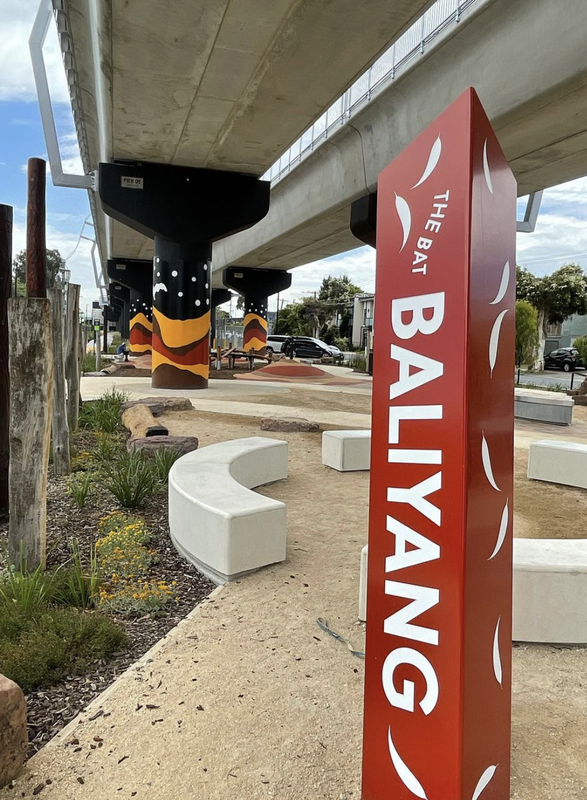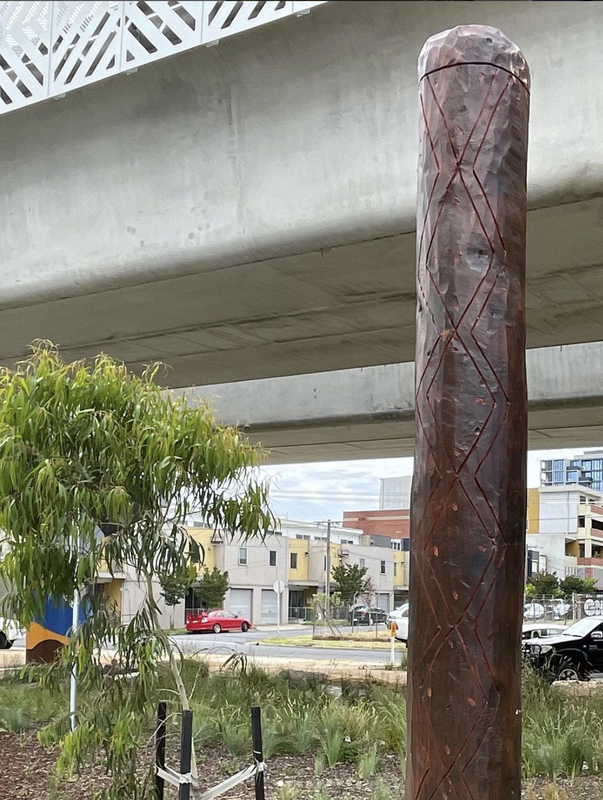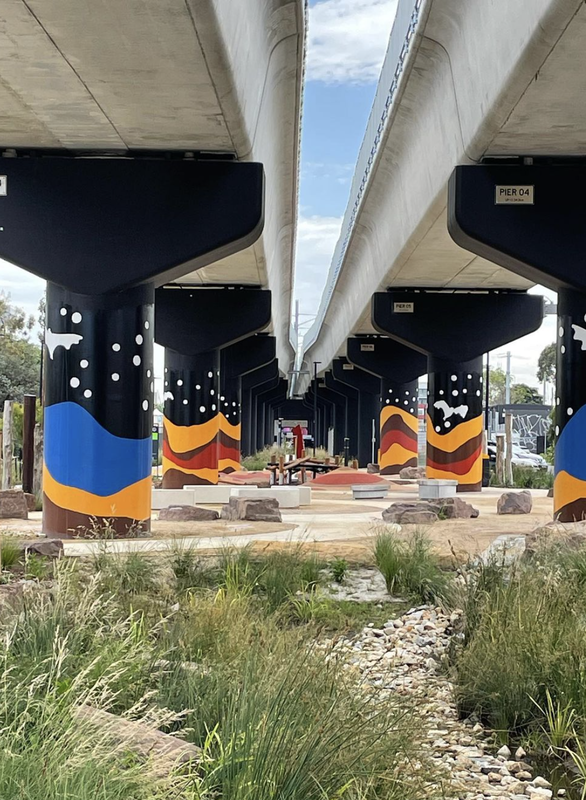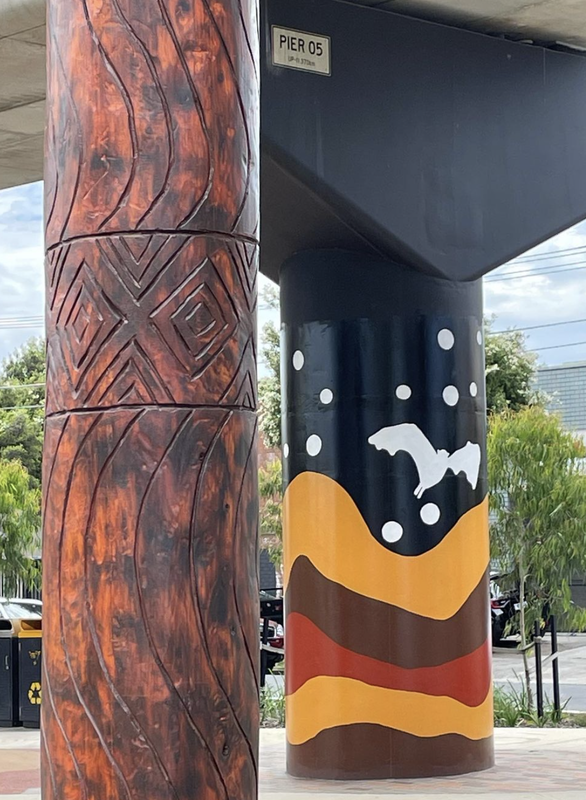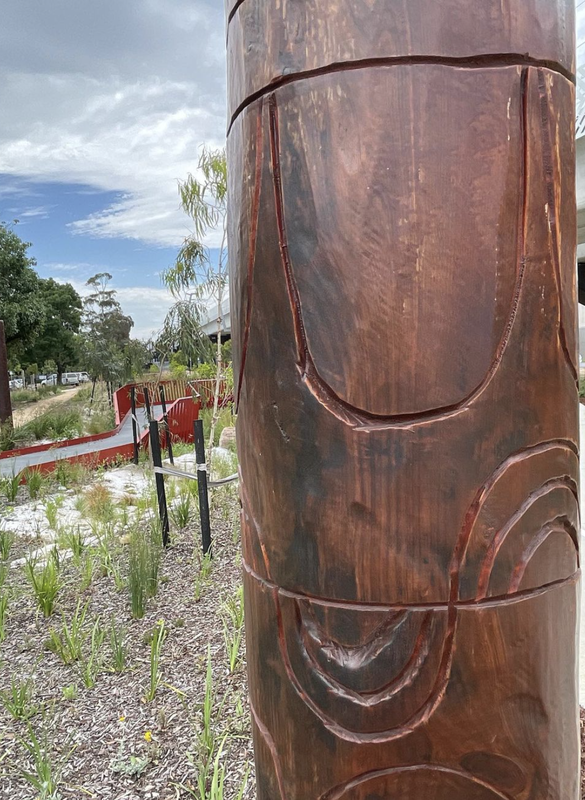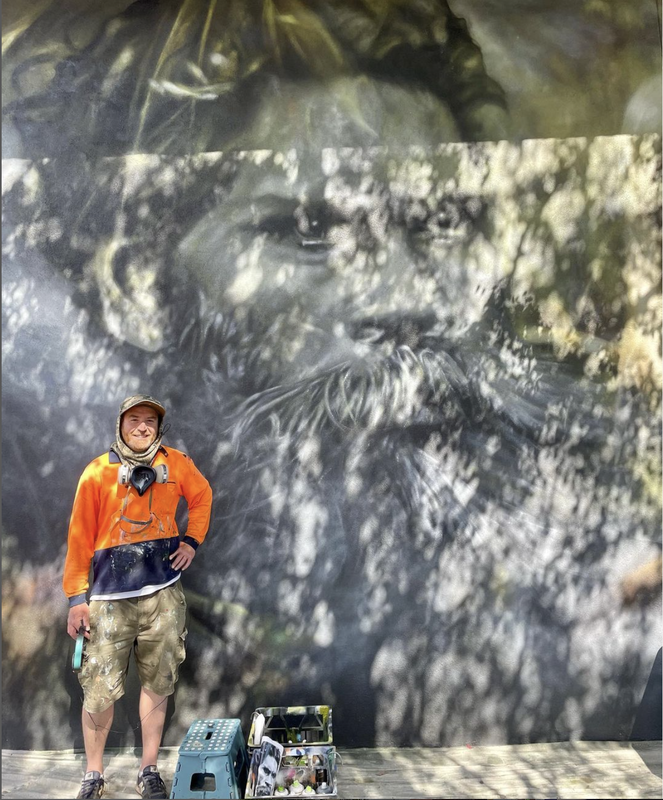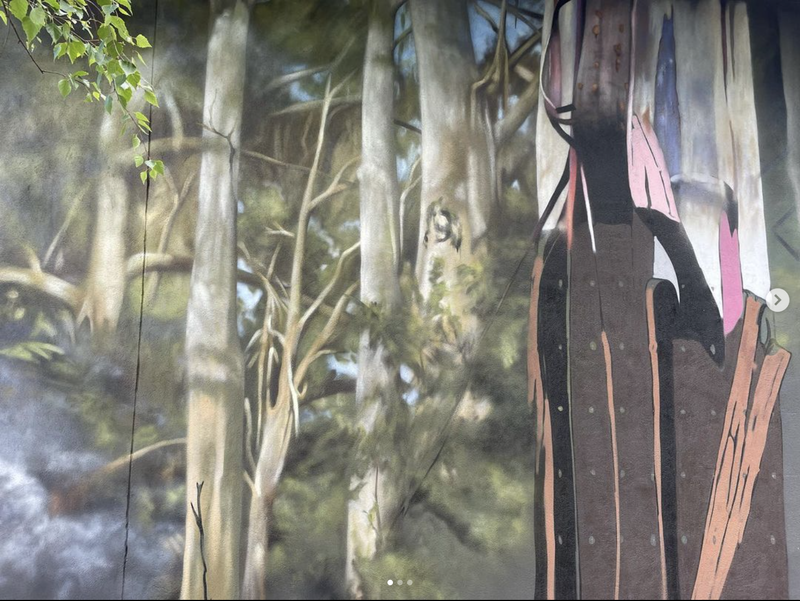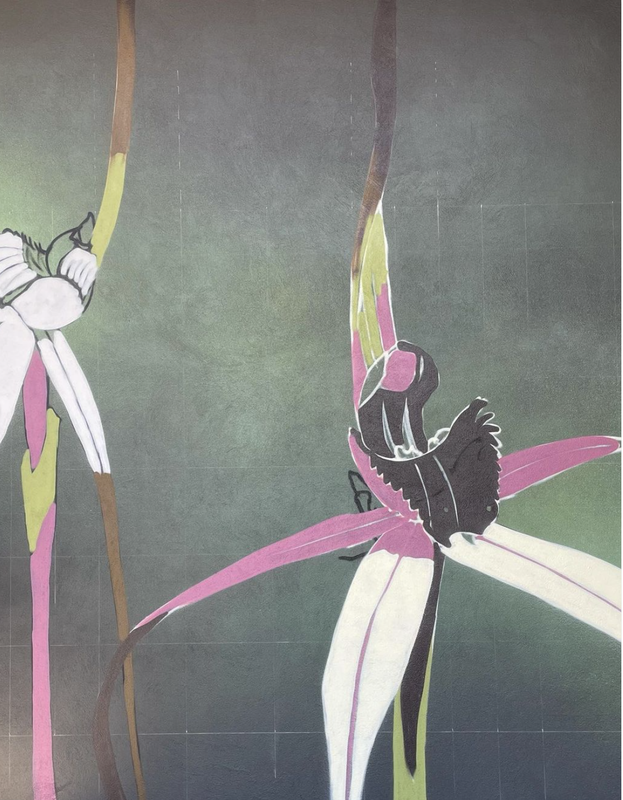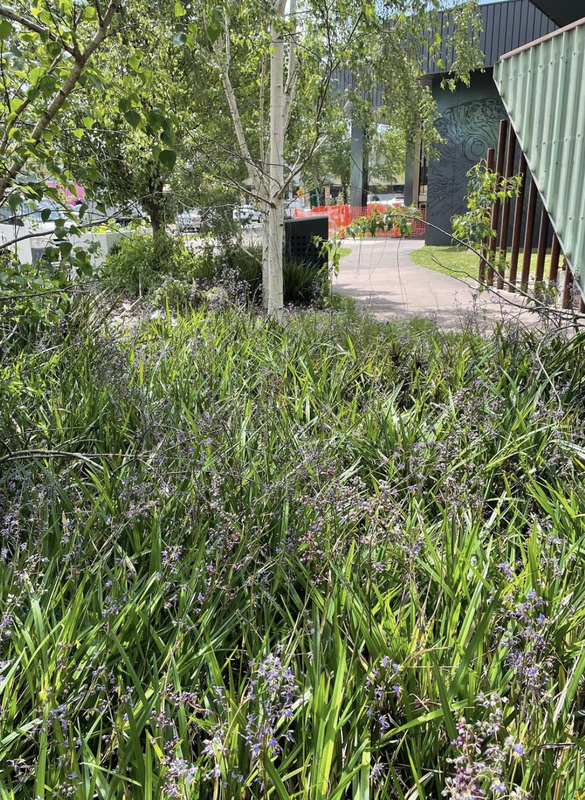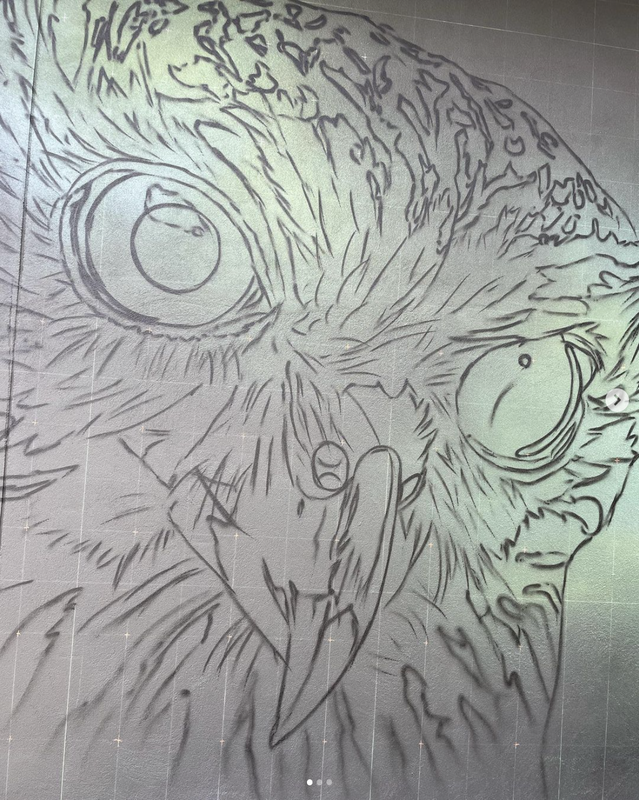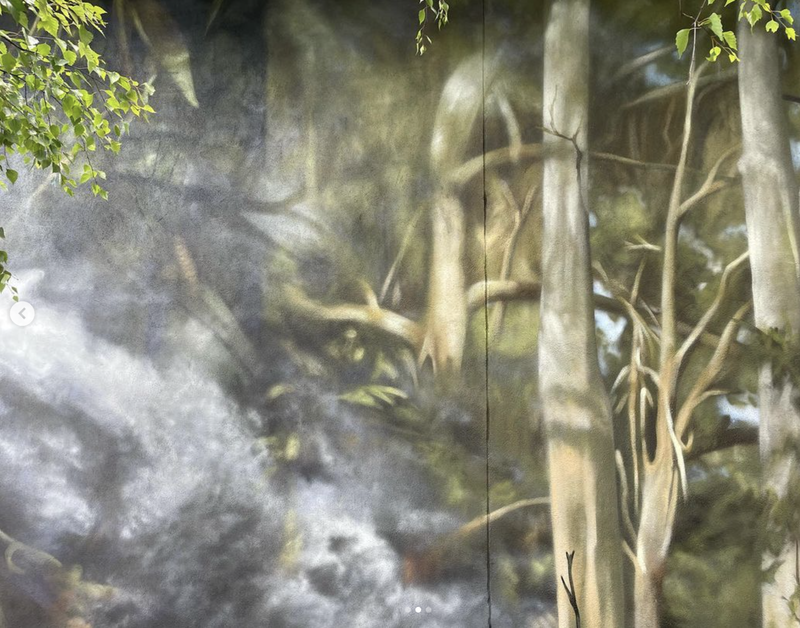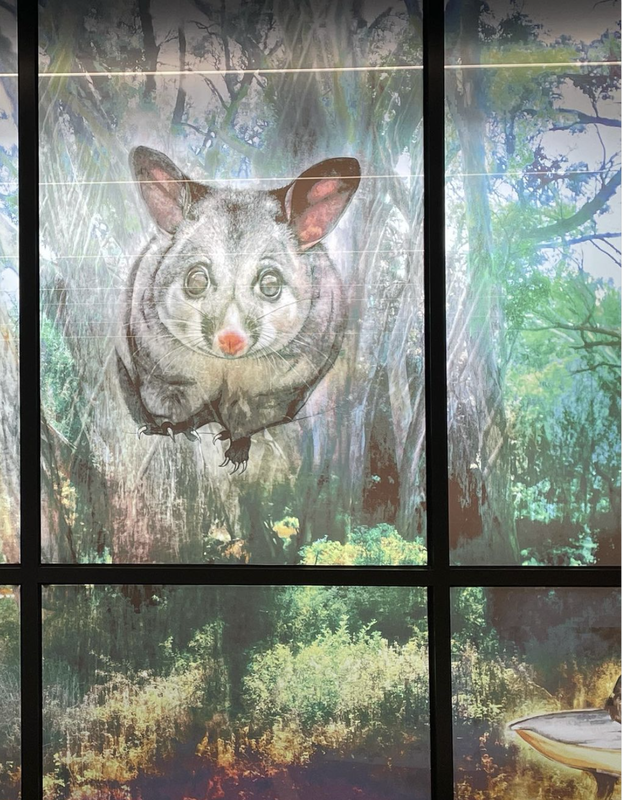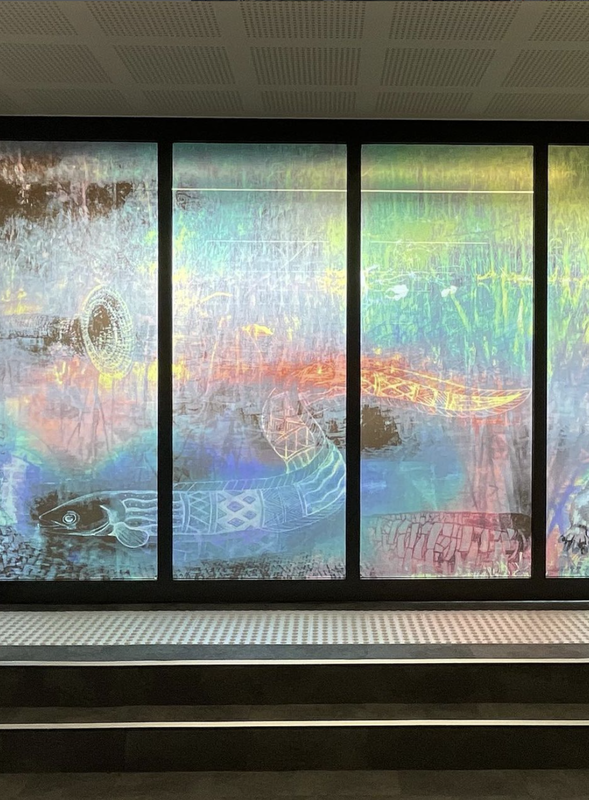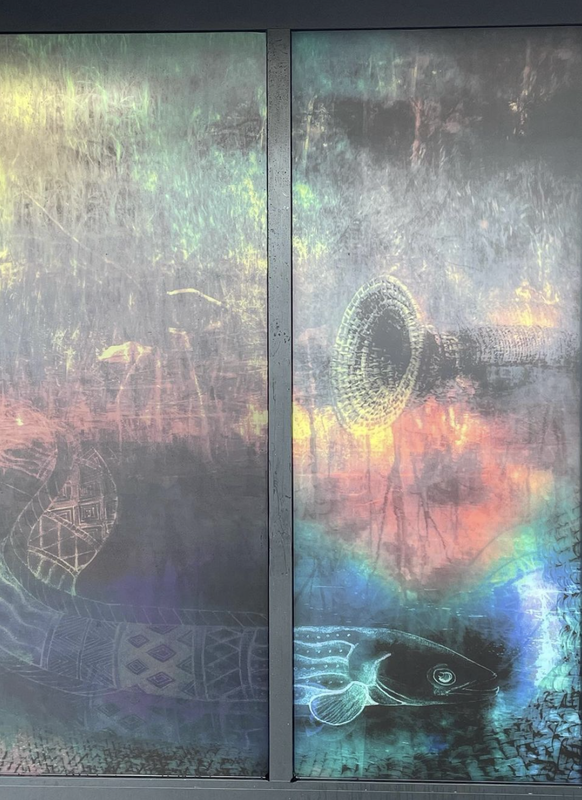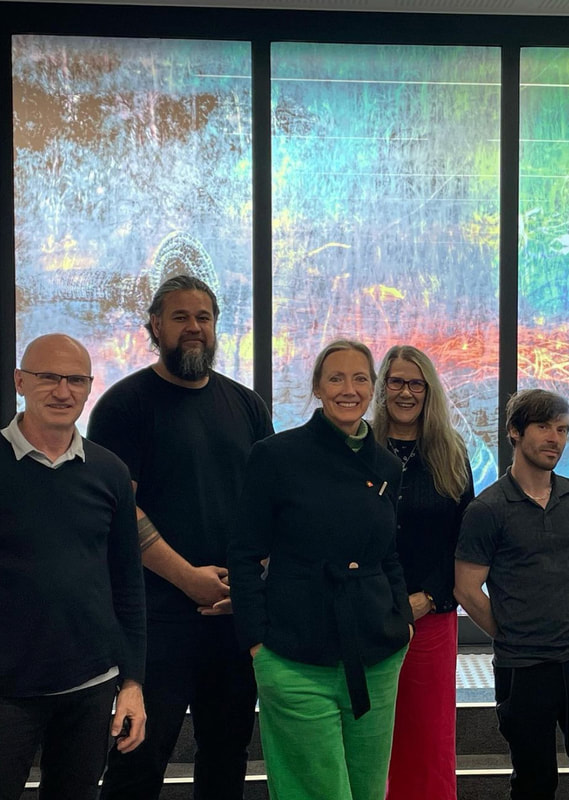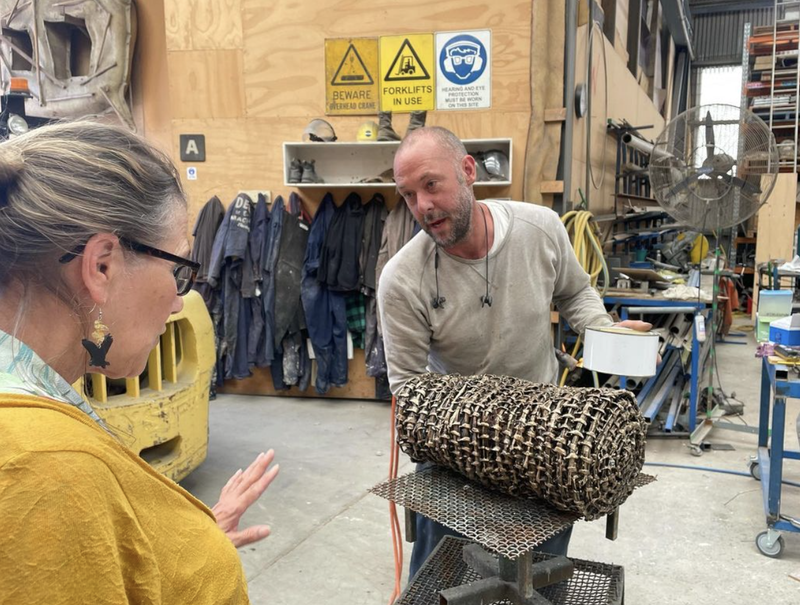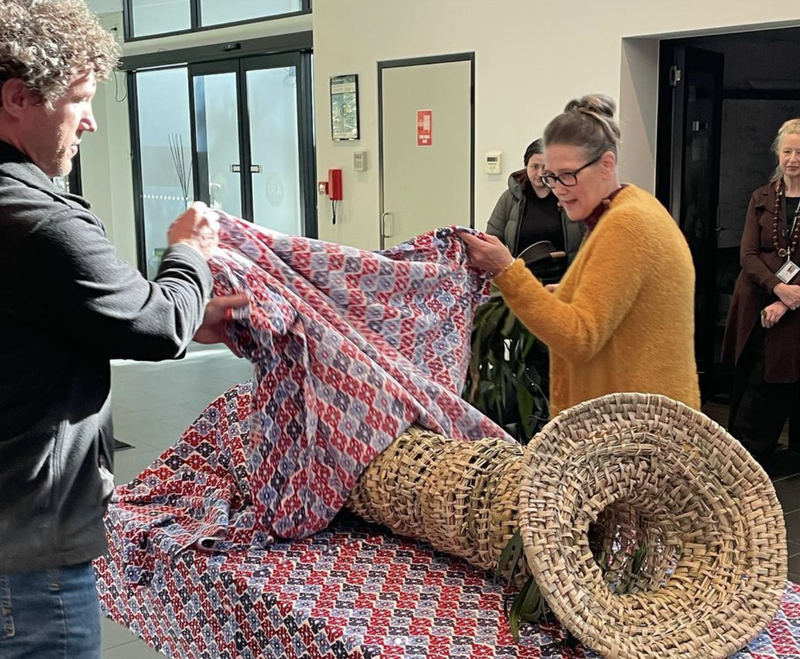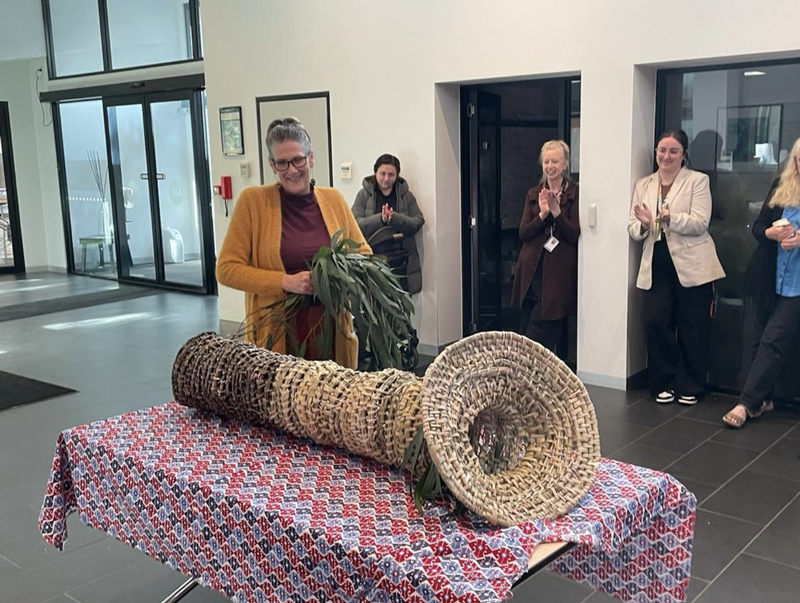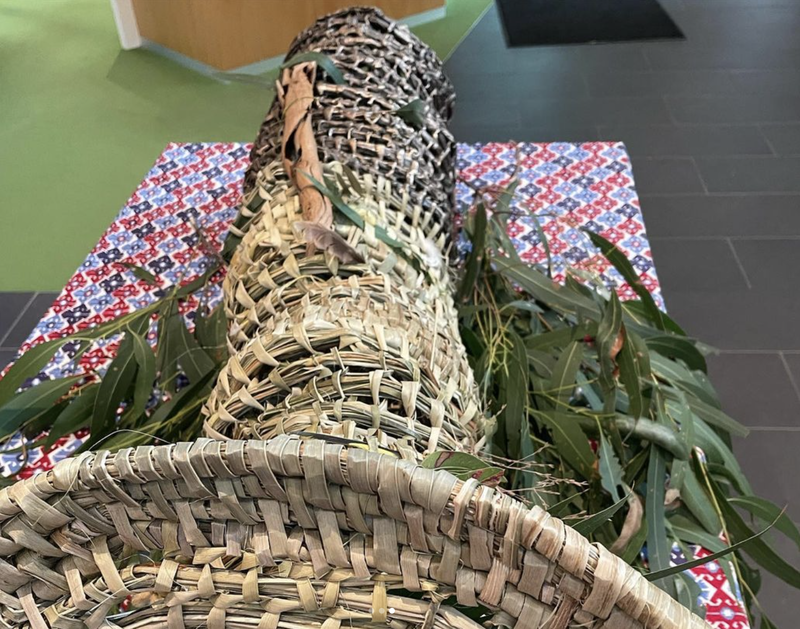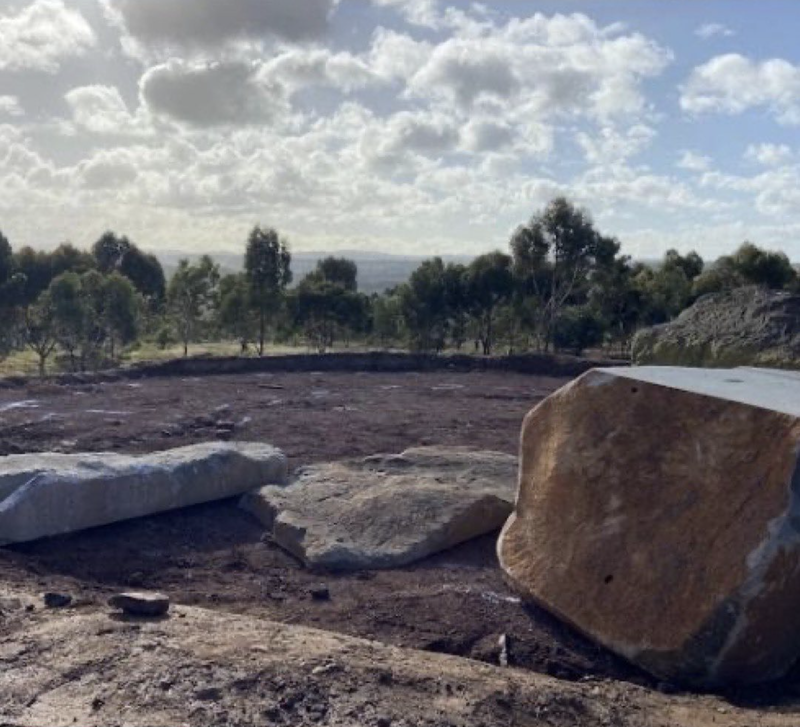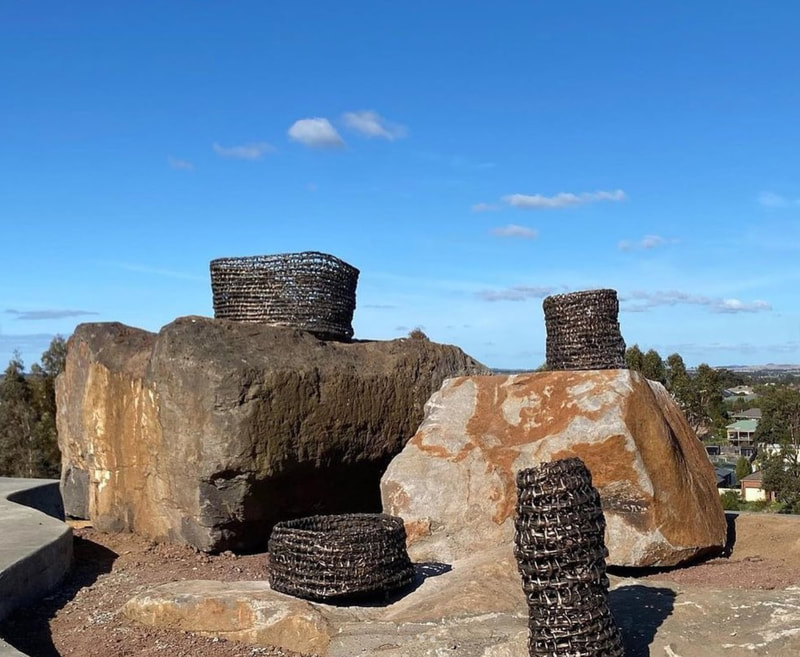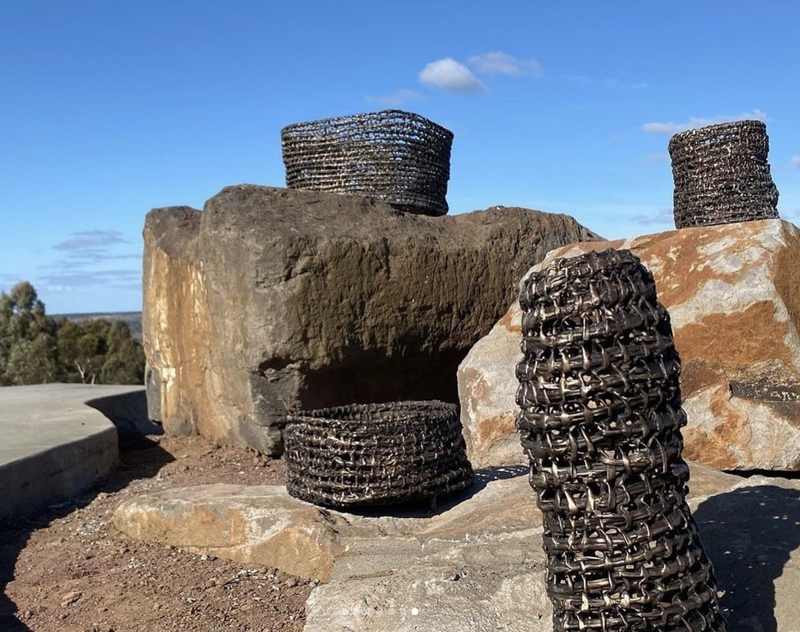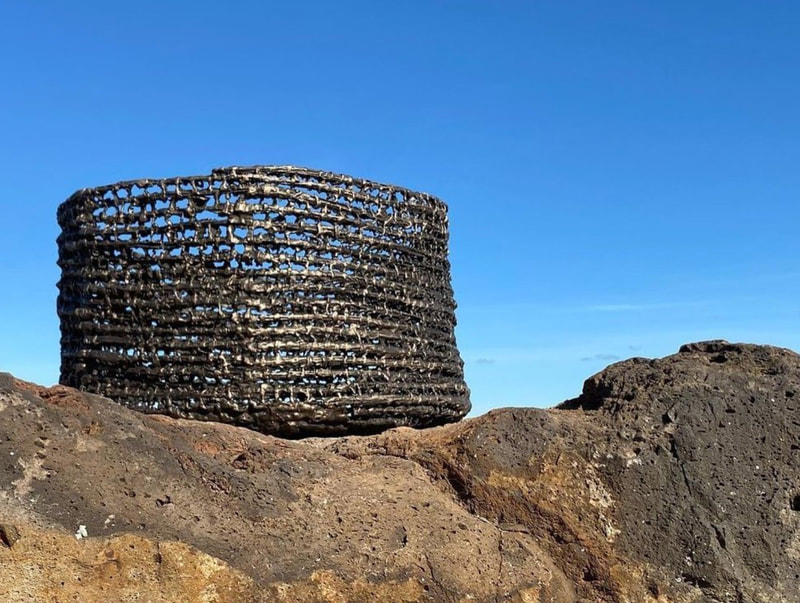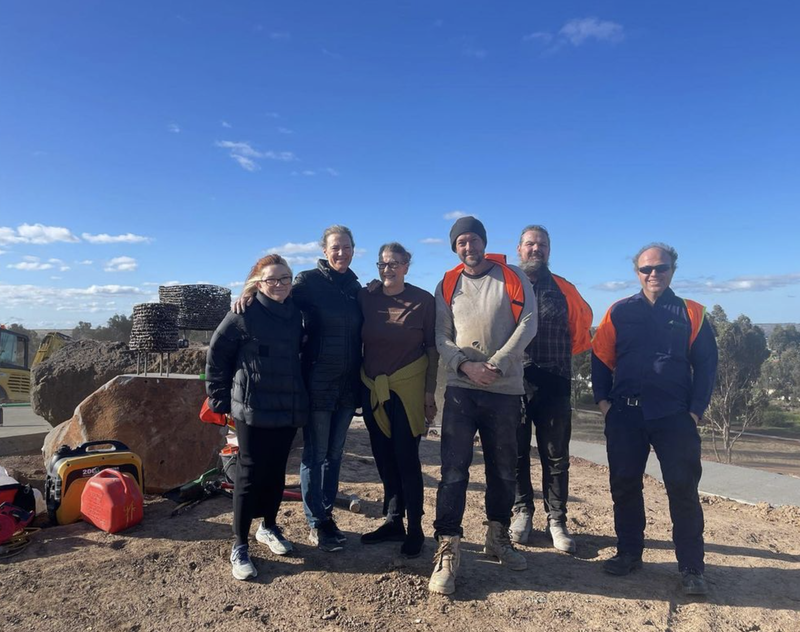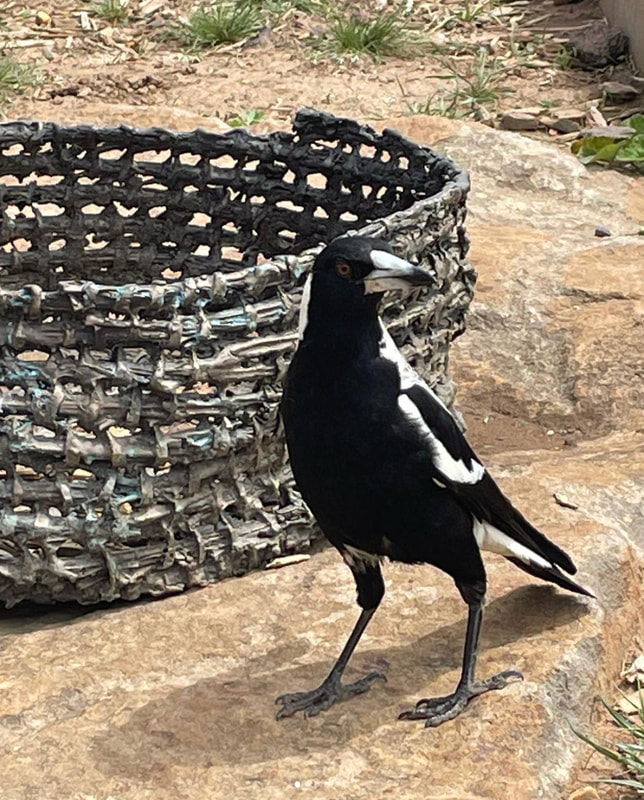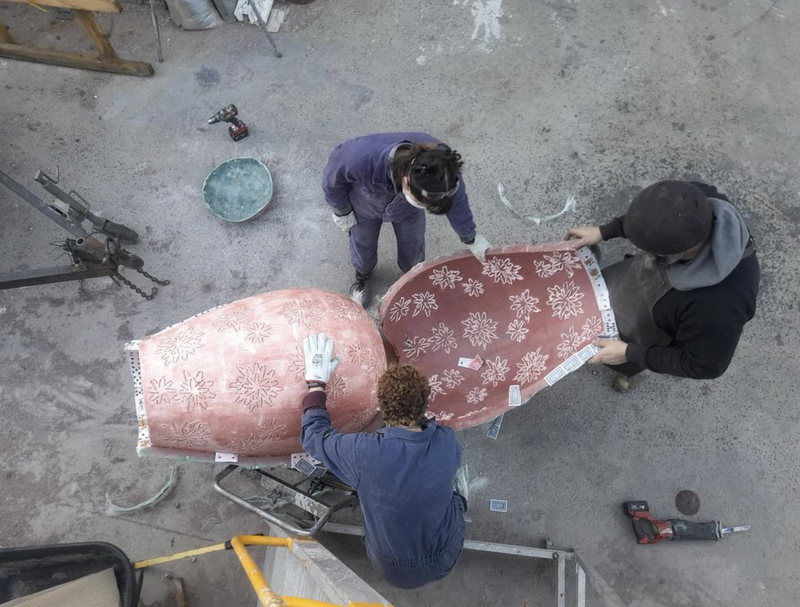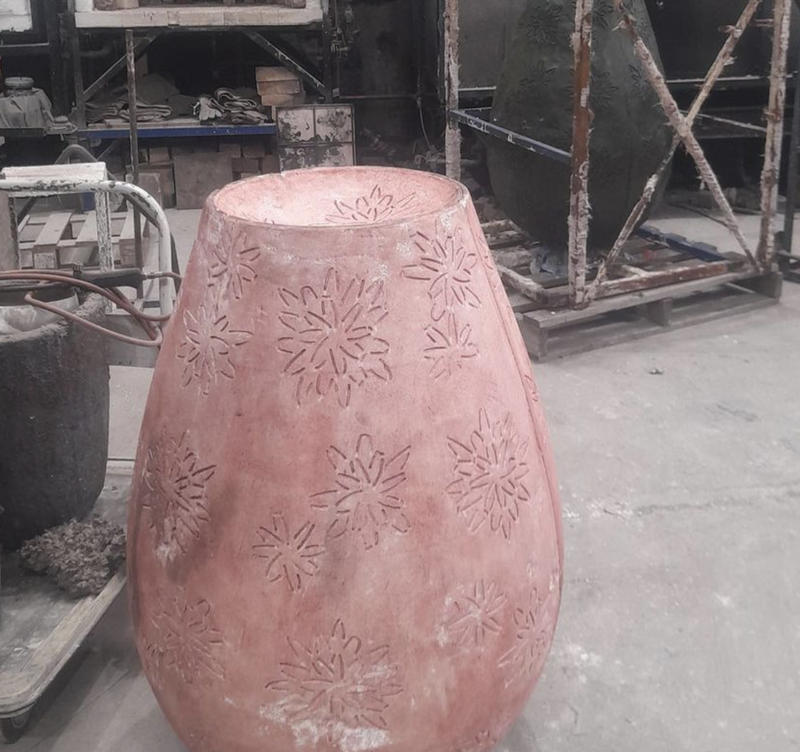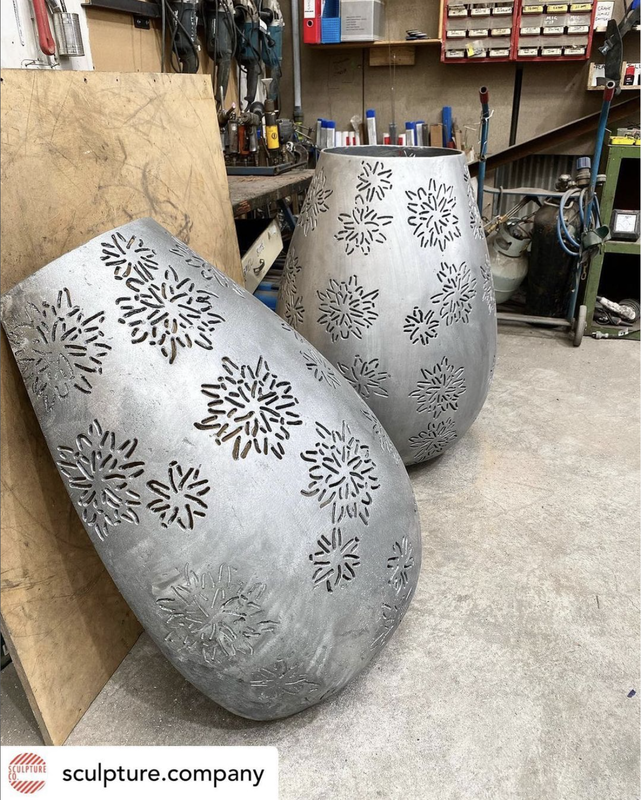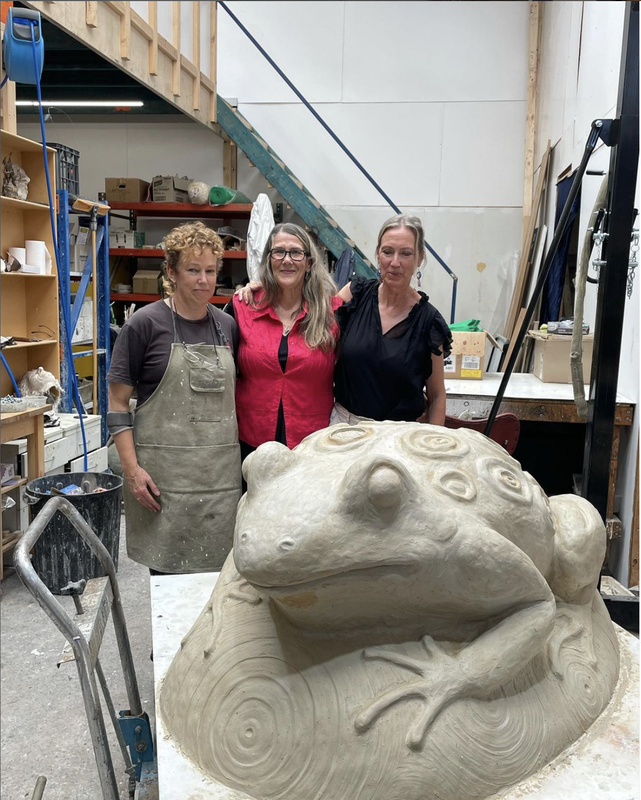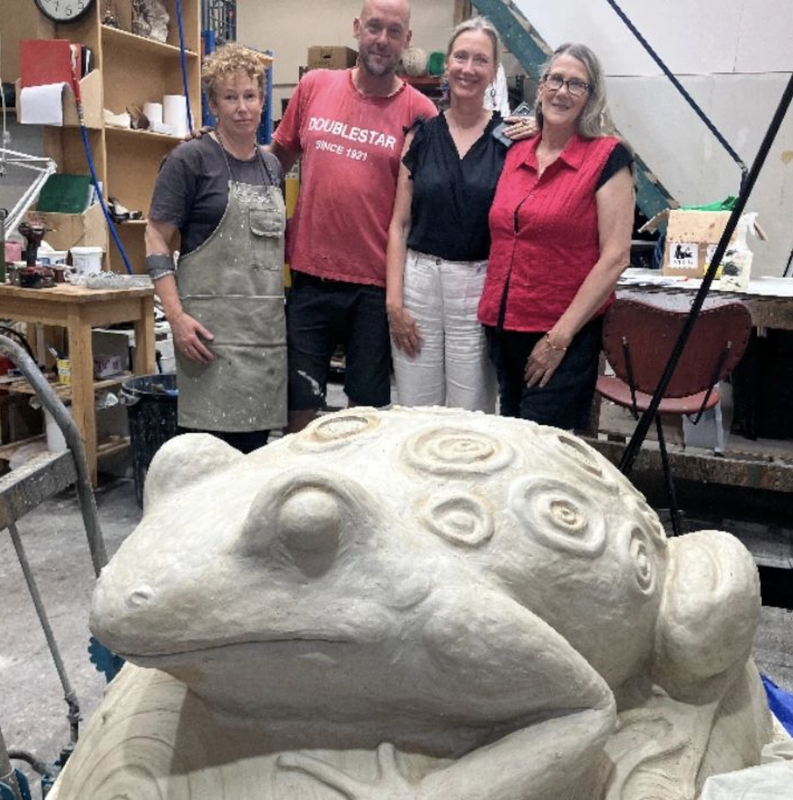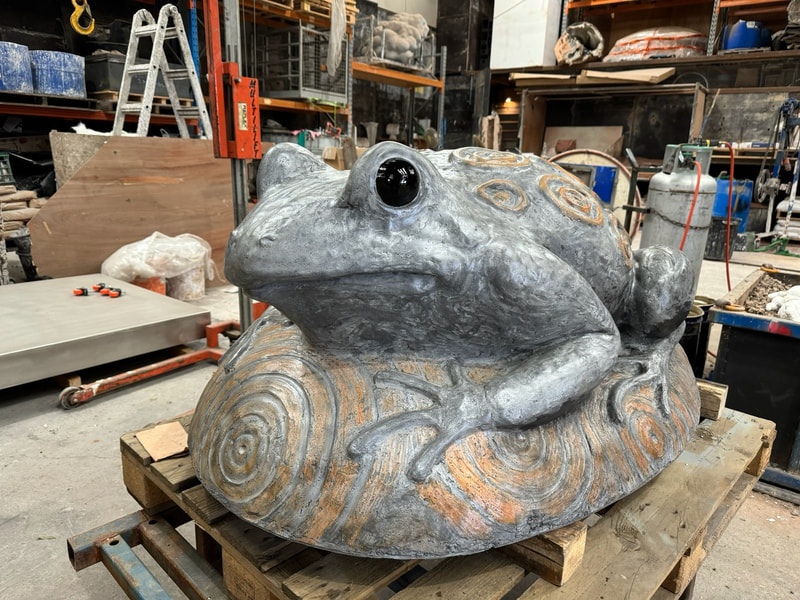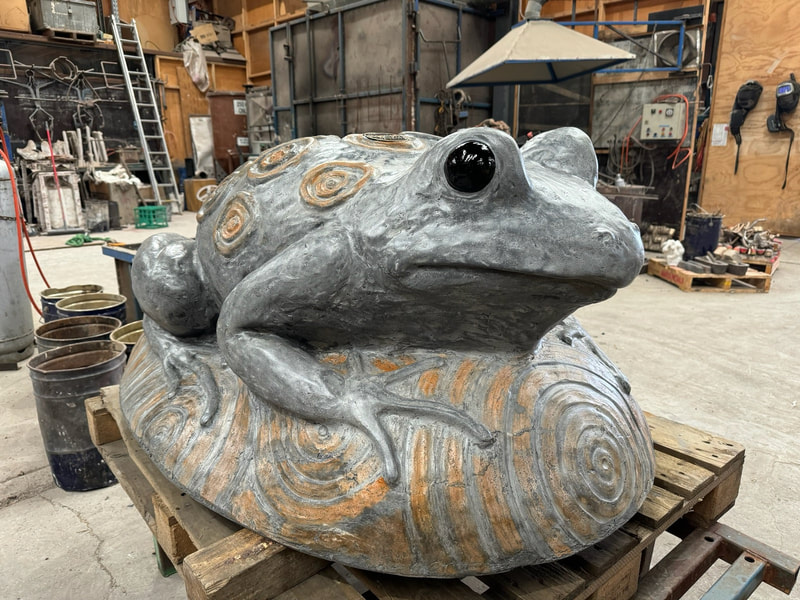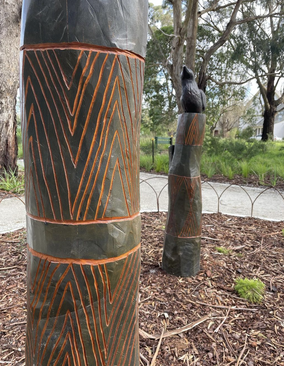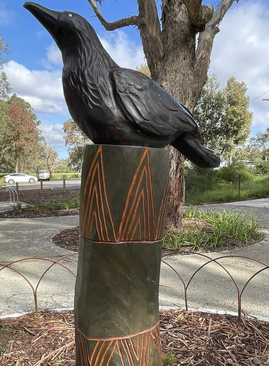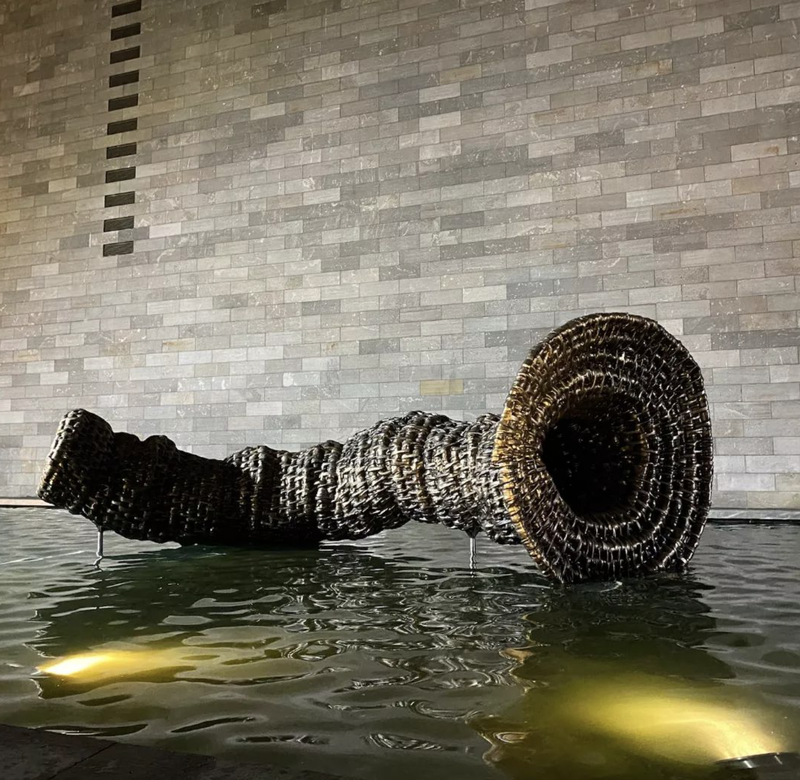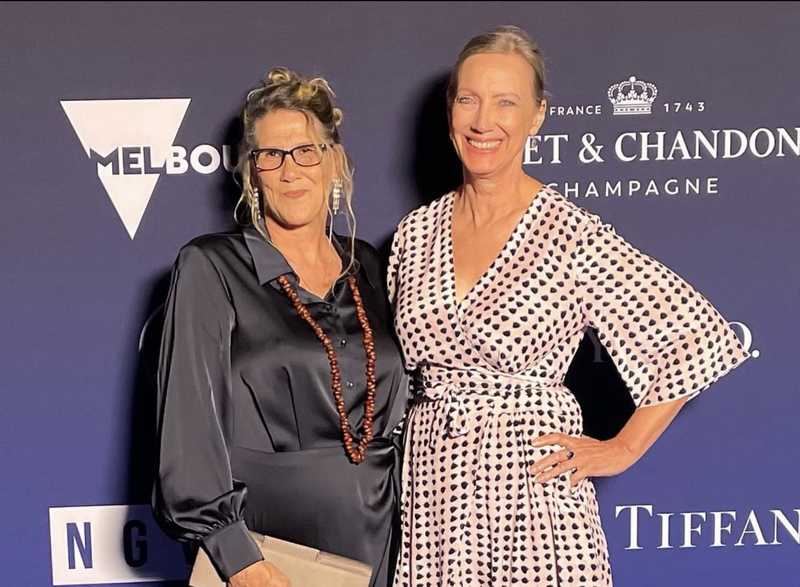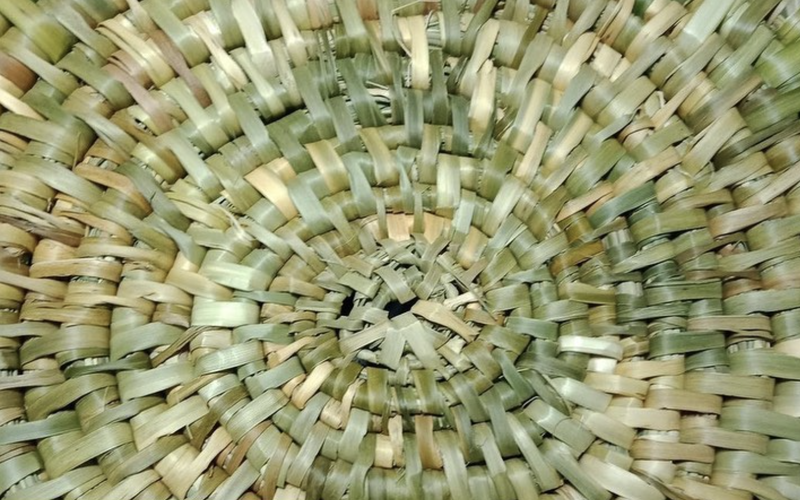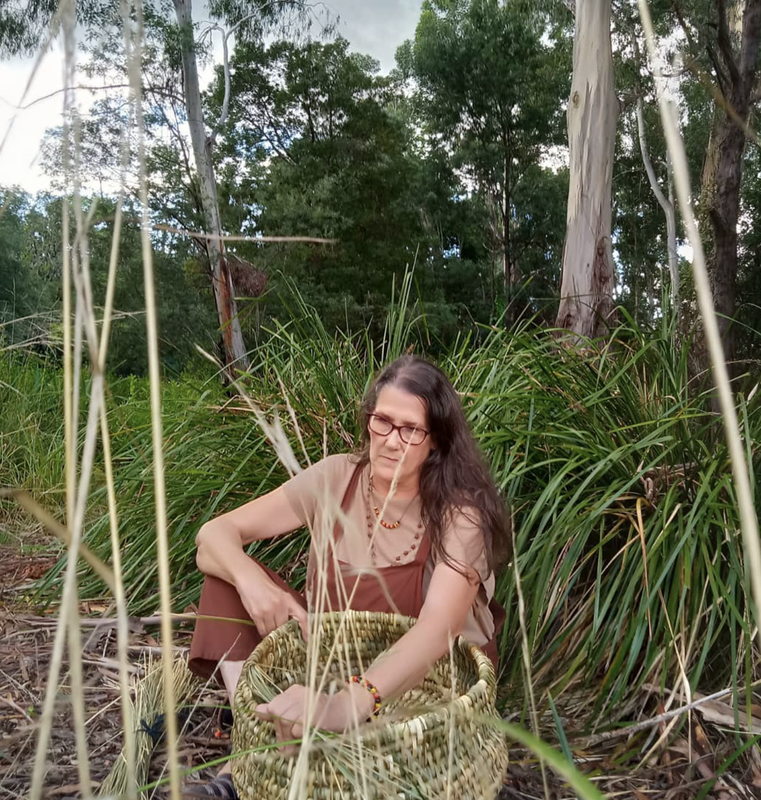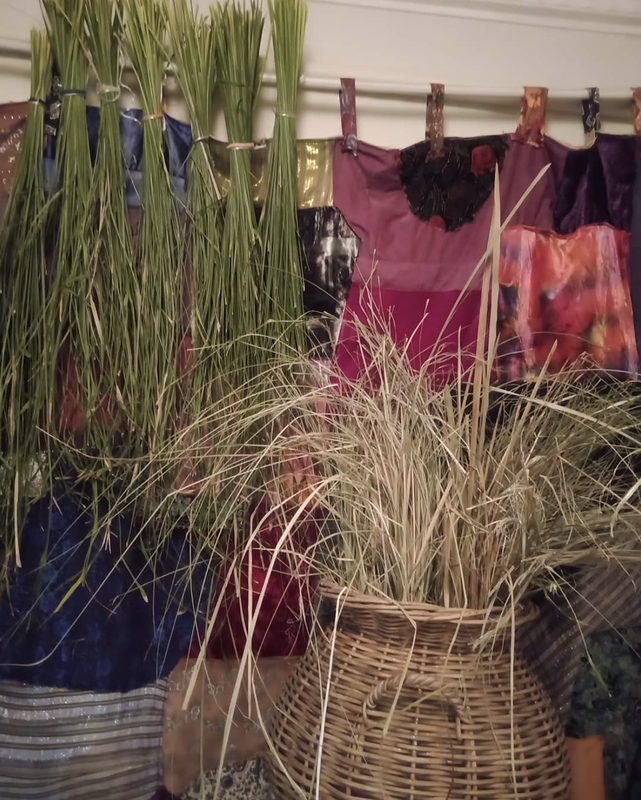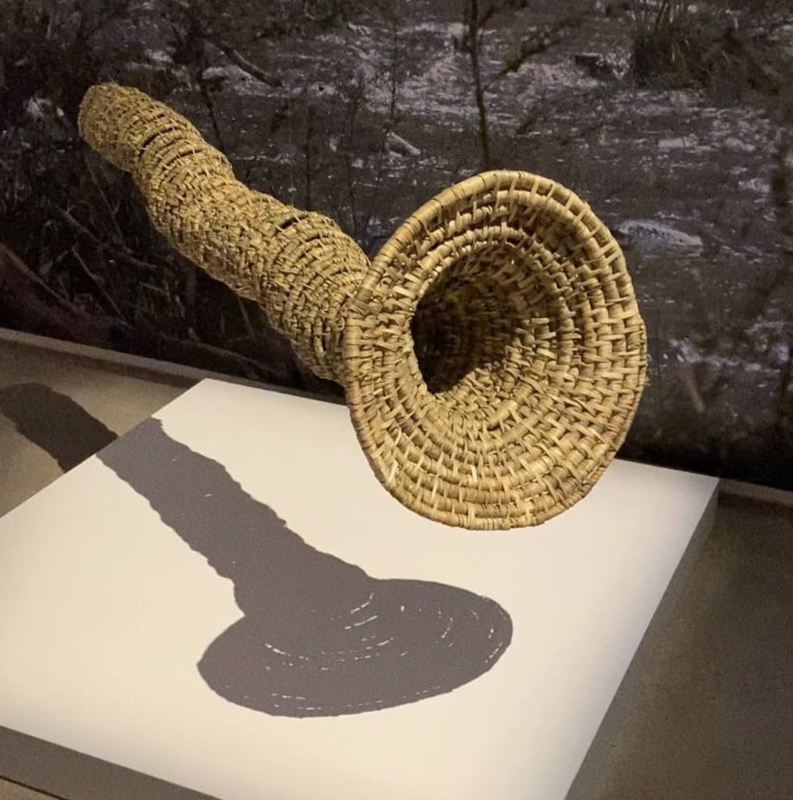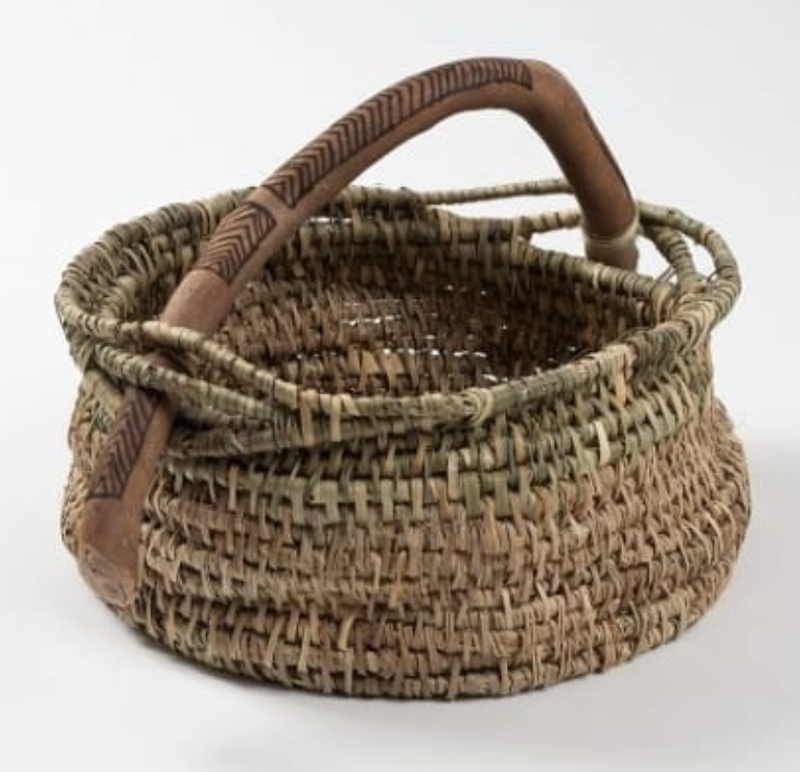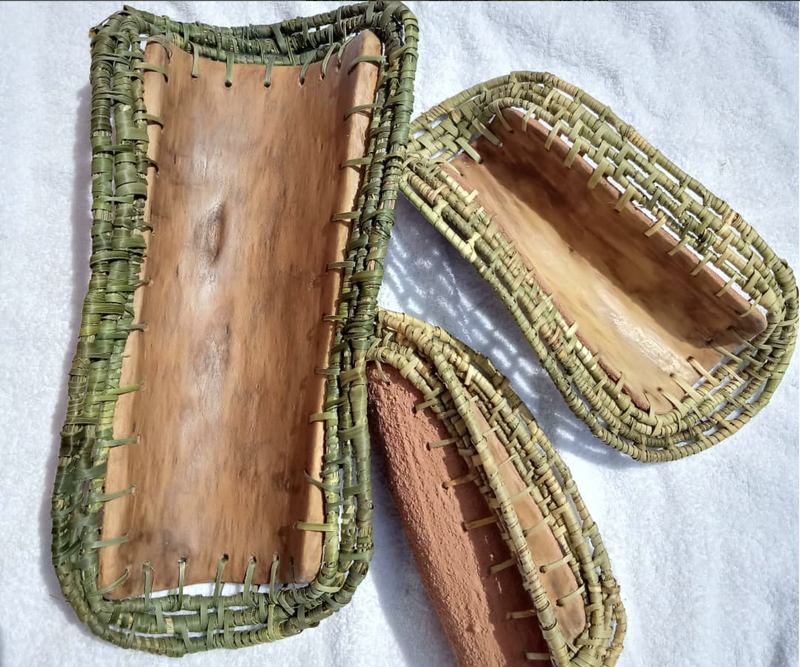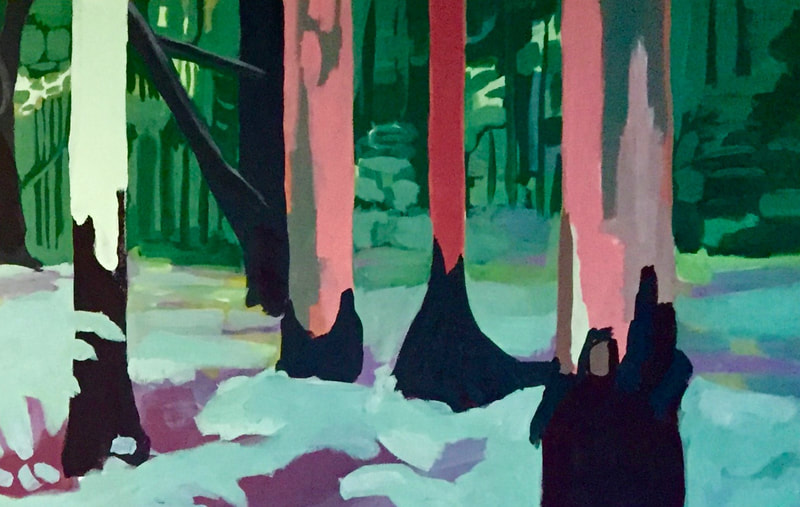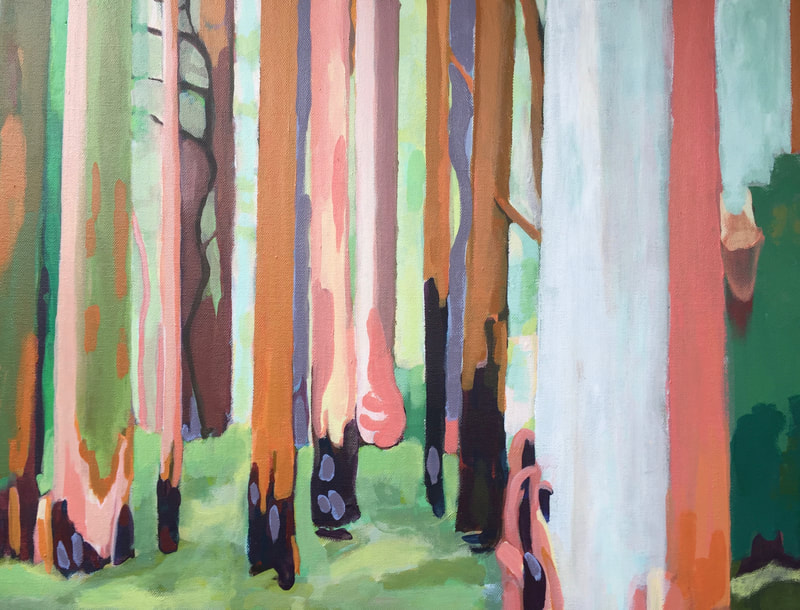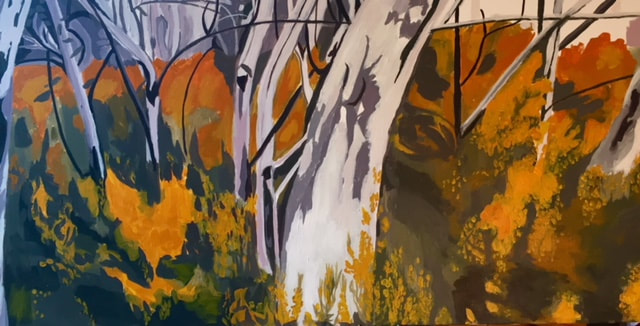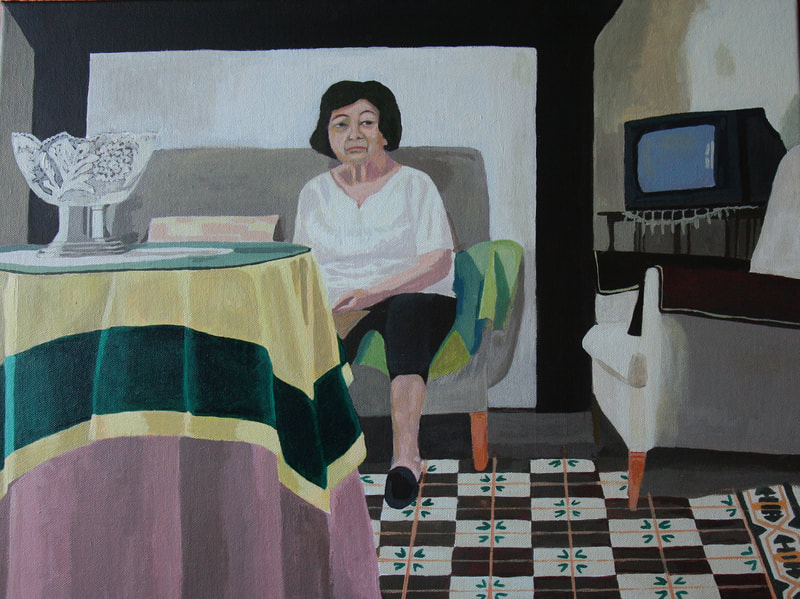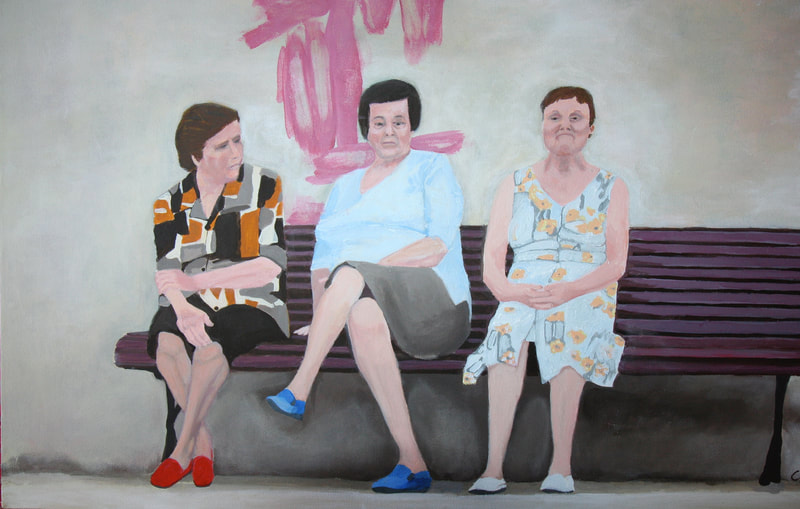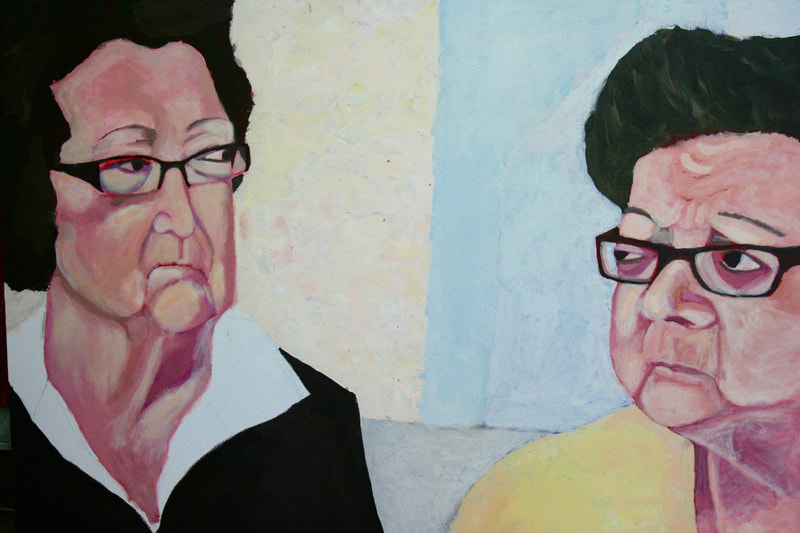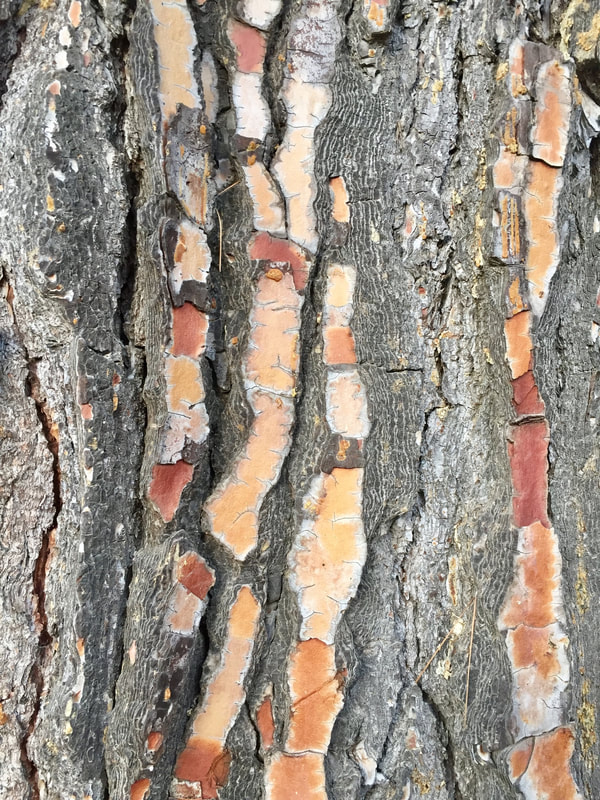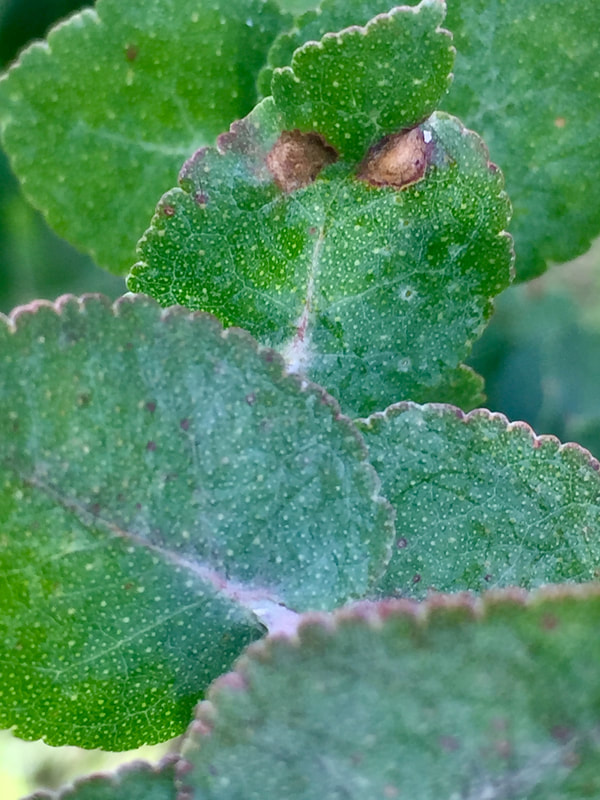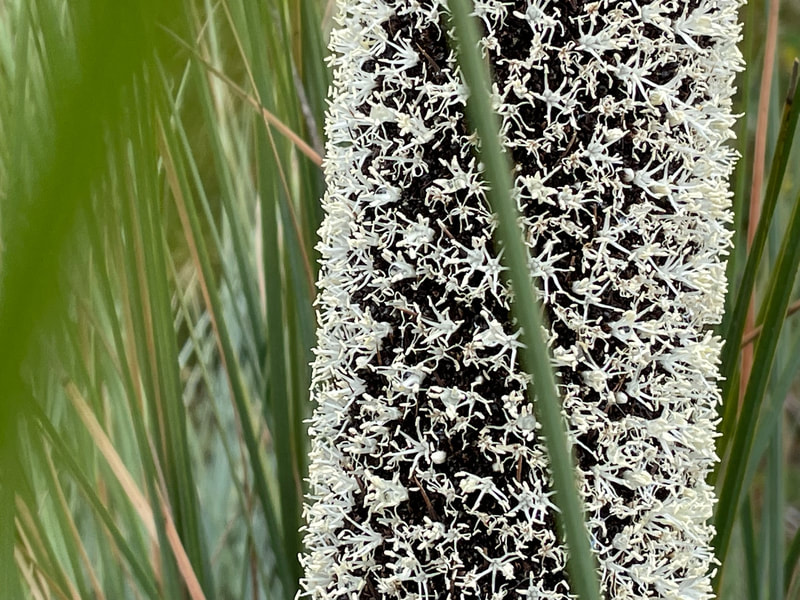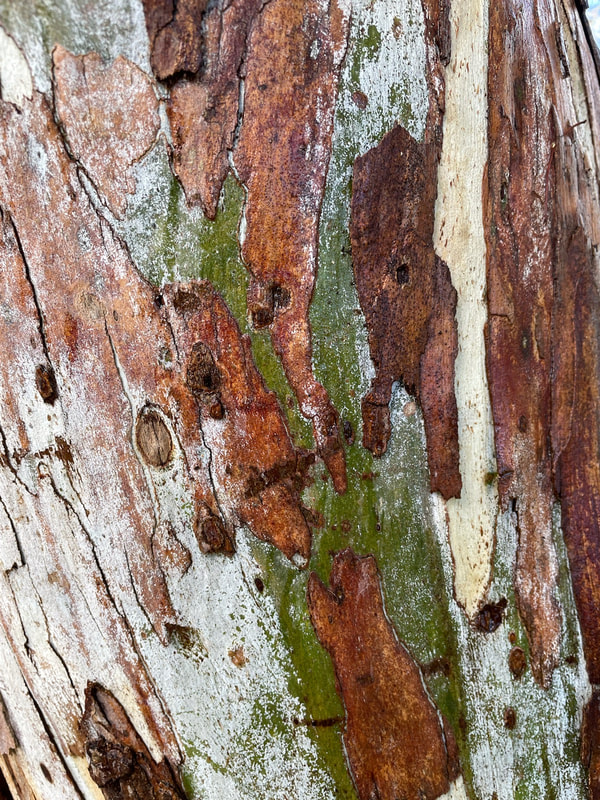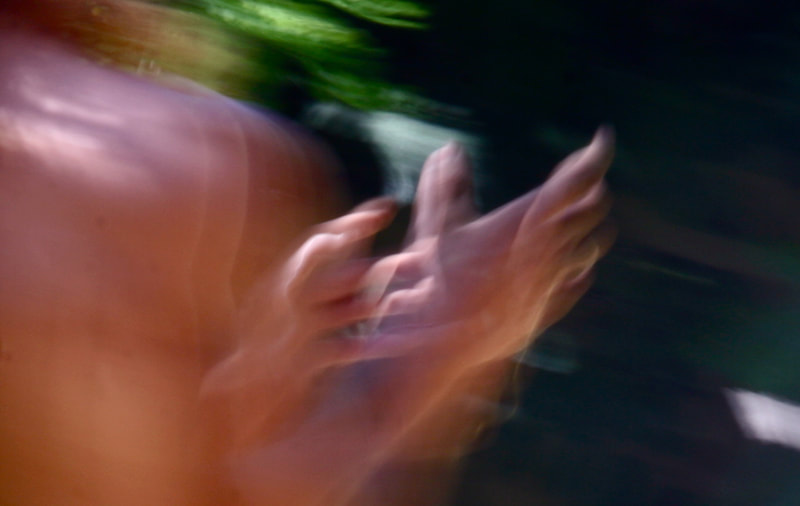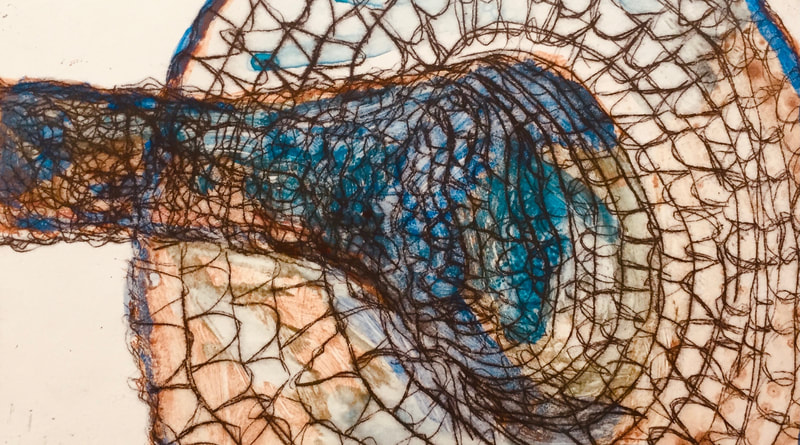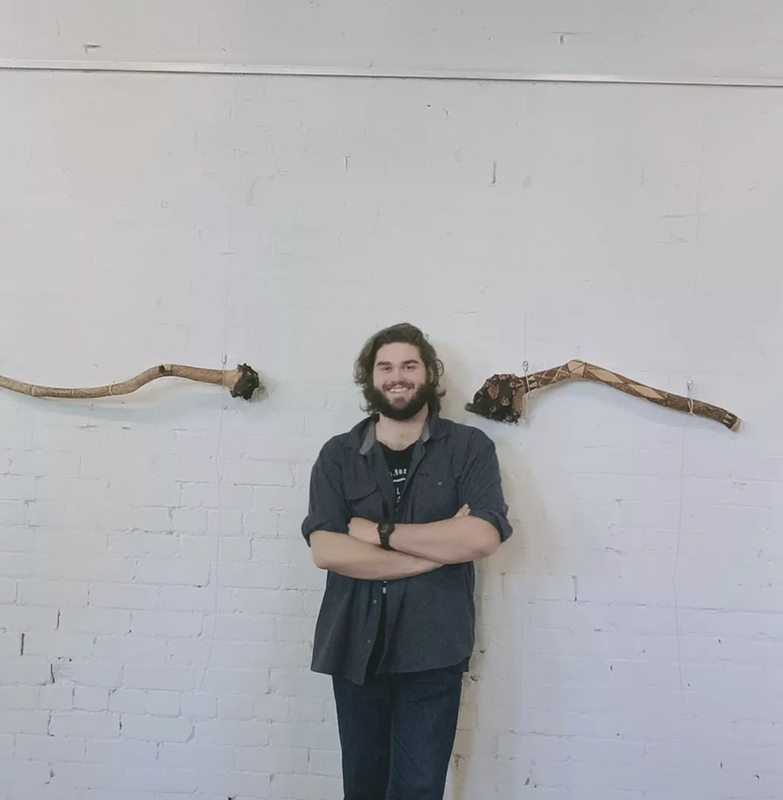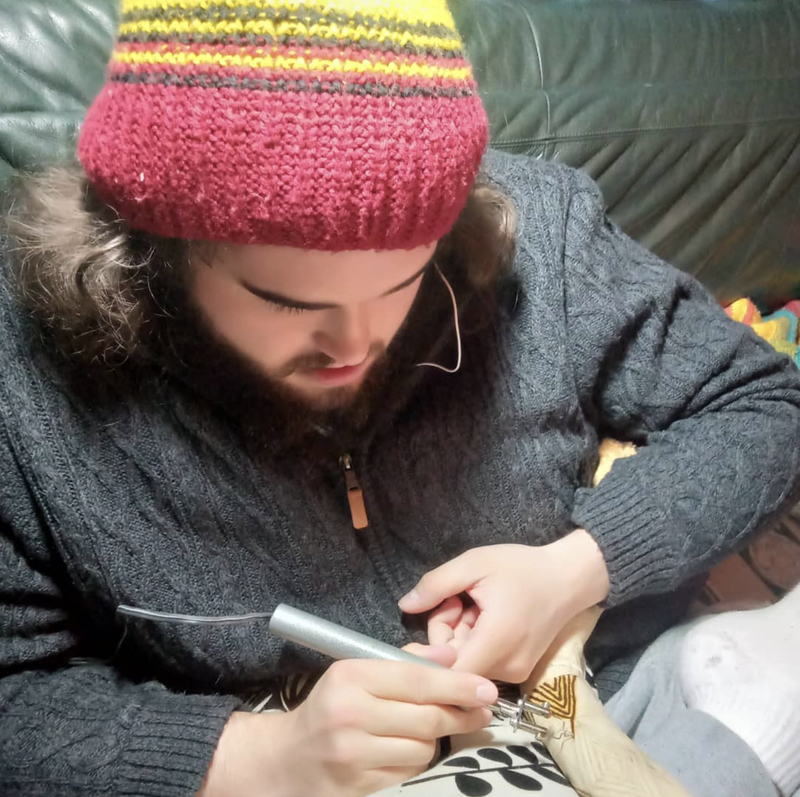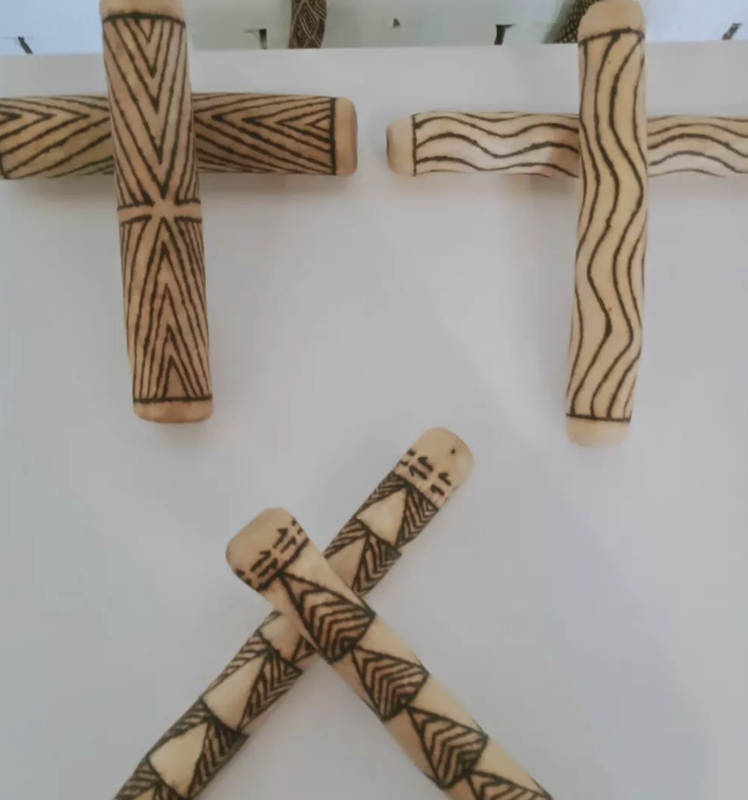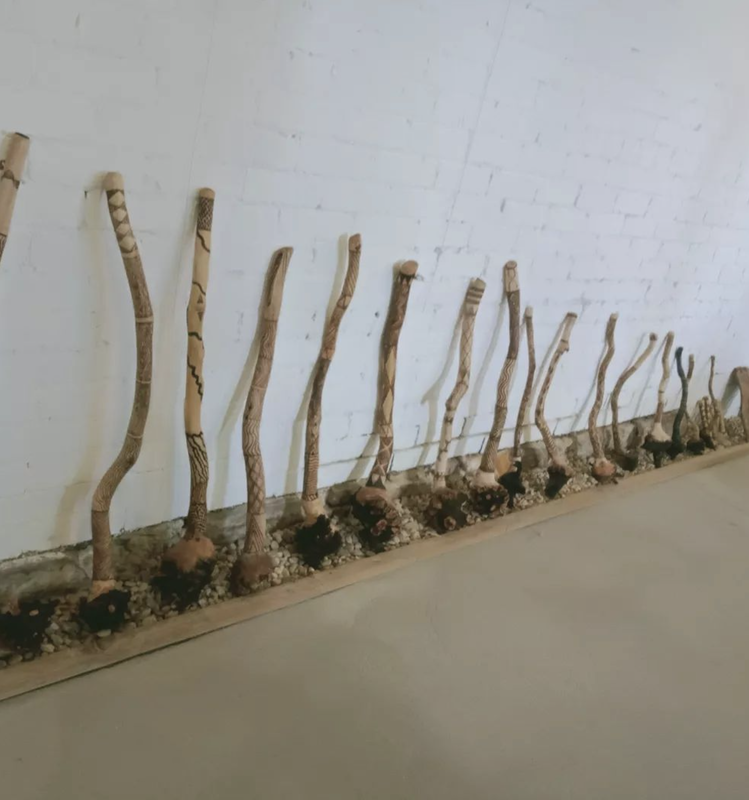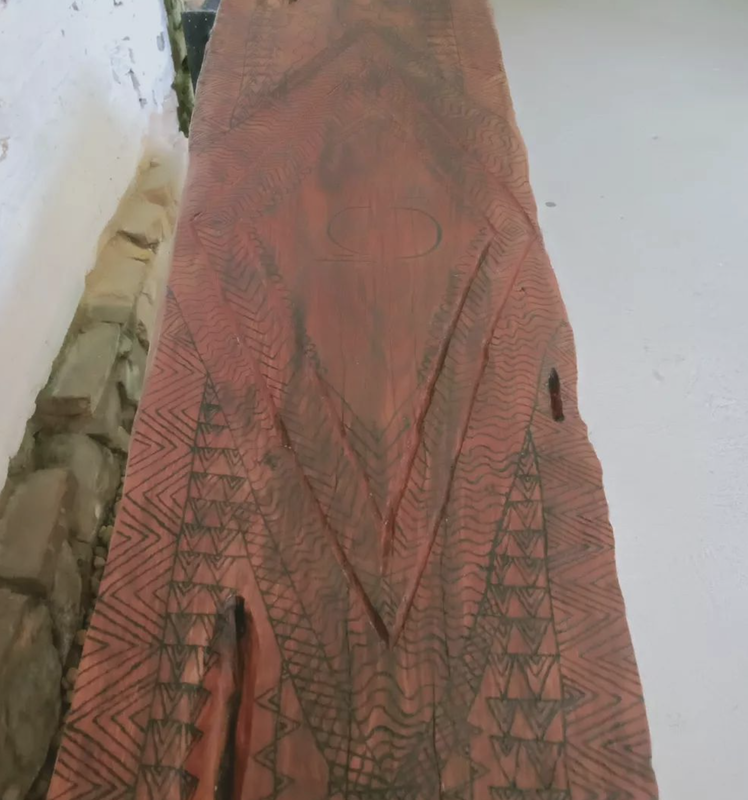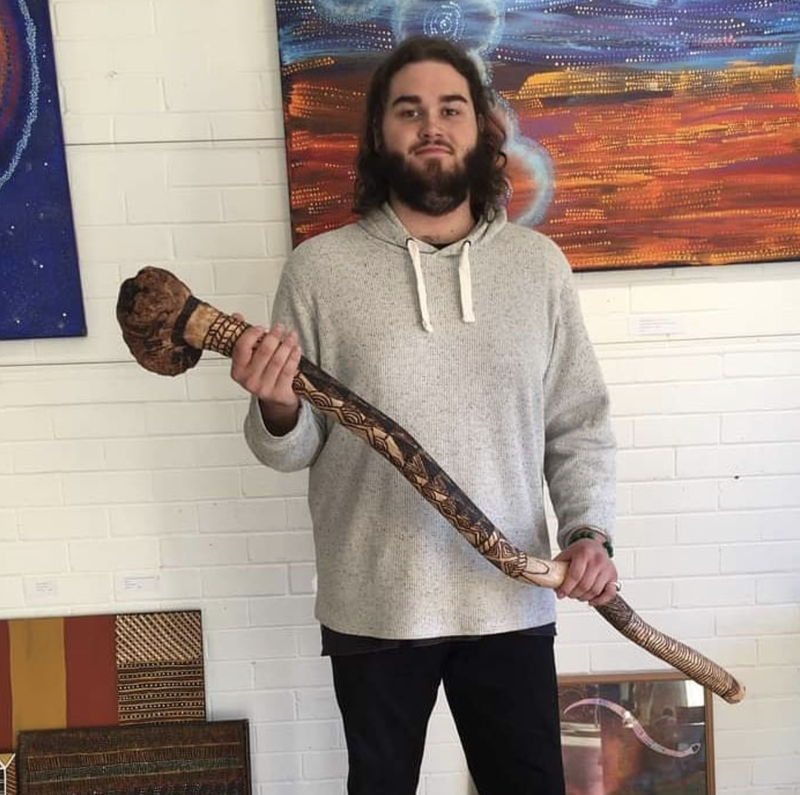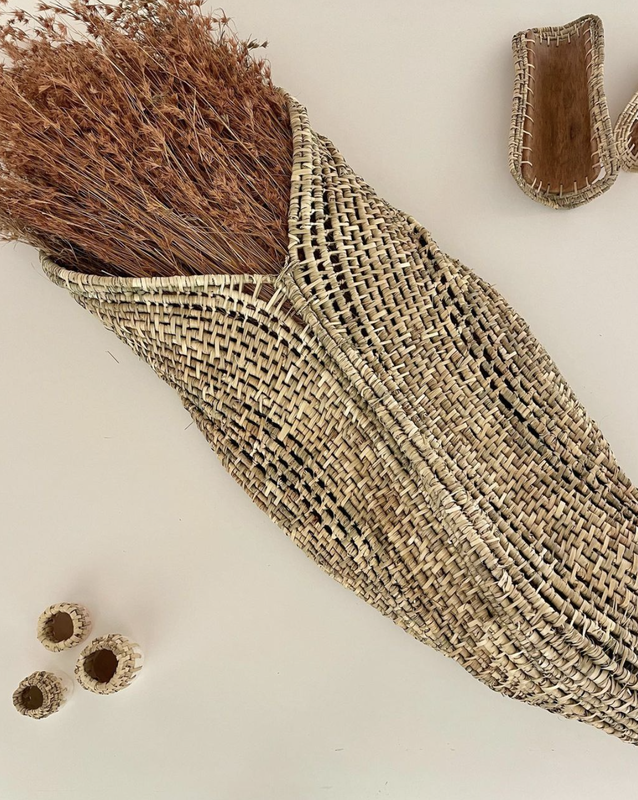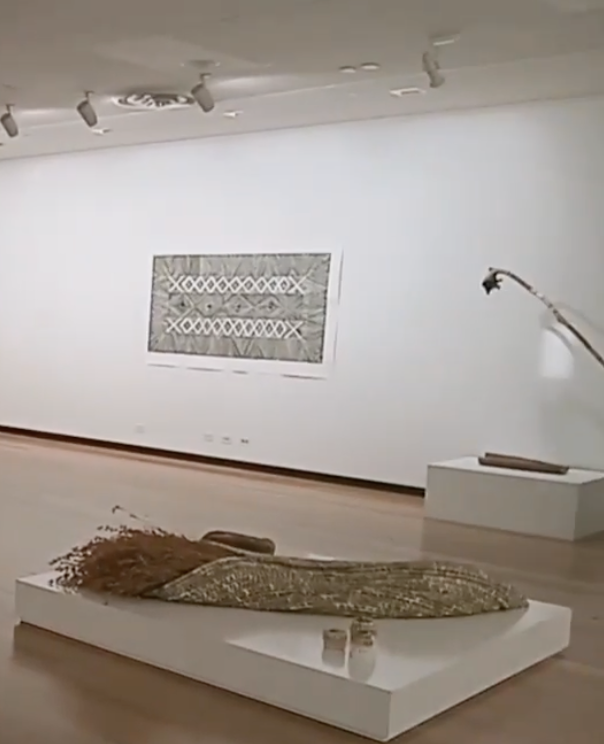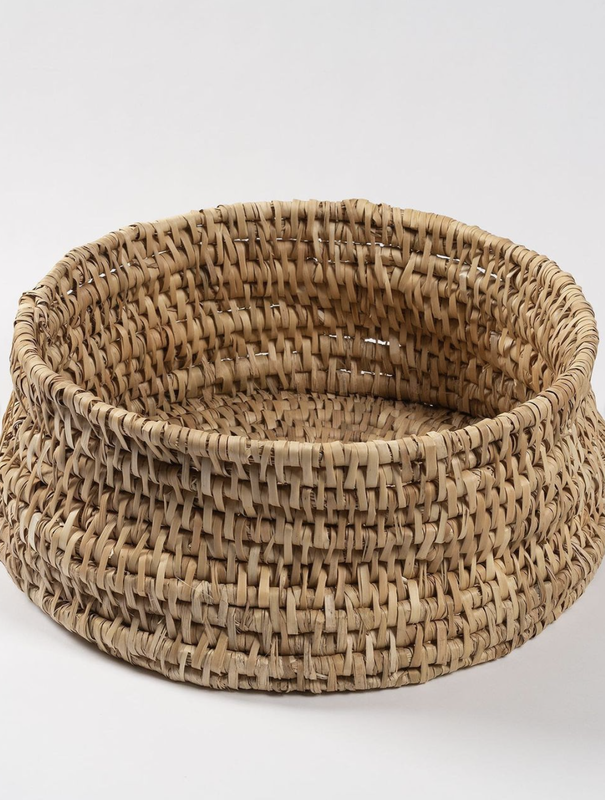Murrup biik PUBLIC ART
Murrup Biik is a public art collaborative created by Aunty Kim Wandin and Christine Joy.
'The essence of Murrup Biik, as an Aboriginal person, is knowing that I come from Country and I am Country and that everything we do affects Country at all levels. It's about deep listening, to hear what Country is saying to us'. Aunty Kim Wandin
Our design work is committed to active philosophy of reciprocal relationship with Country which includes:
- honouring and acknowledging Ancestors
- honouring all things Country
- holistic
- holarchic rather than herirarchical
- Country-centric as a priority rather than human-centric
- telling the narrative of plants animals waterways, the layers of Country
- working with the intangible
- actively healing Country through our work
- keeping cultural practice alive
- bringing awareness to community
- a political statement of Aboriginal survival
- site-specific sensitivity
- use of language and ceremony
- promotion of healthy collaborative creative practice between Indigenous and non-Indigenous teams, as vital to respectful dialogue and conciliation. We have valuable insights to share as a partnership, practising within the art and cultural sectors across all levels of government, with private enterprise and with NFP's, including experience with the following dynamics: racial and gendered 'othering' and exoticism, racial and gendered stereotyping, paternalism, reverse discrimination, racial and gendered 'eclipsing', The Matilda Effect in the Arts, the impacts of institutional policy box-ticking (often referred to as 'black-cladding' or 'white-washing'). We see this dialogue as vital to the education toolbox for anyone working with mixed cultural (and mixed gender) artistic partnerships and are happy to share our insights with you. We understand your curiosity, and respect the challenges you might have to neatly pigeon-hole our projects and partnership, as we that often practice within a cultural framework but we are not totally Indigenous. We are here to answer your questions and respond to your curiosity. We prefer to establish a mutually respectful working relationship from the get-go, and to avoid any misunderstanding, we may request a discussion and agreement with clients on these topics in preliminary conversations.
What we do
We work with a range of mediums and modalities:
- installations
- community art
- landscaping
- curation
- interiors and exteriors
- ephemeral and permanent
- small and large scale
- consultation
- ceremony
- interpretation and education
- written narrative and concept development
WHO WE ARE
Aunty Kim Wandin (Wandoon)
Aunty Kim Wandin is a Wurundjeri Elder of the Woi-Wurrung language group. She has lived and worked 'on Country' in Healesville her entire life. Her traditional basket making has been handed down to her by direct lineage: from her Grandmother, her Great Grandmother and the Ancestors. Aunty Kim's work represents a significant cultural position within the South East of Victoria as part of an important group of arts practitioners. Her work adheres to and references traditional cultural practices.
As a leading Aboriginal artist, Aunty Kim is exploring contemporary genres that both enhance and complement her design work, basketry and fibre pieces. Her work speaks of space, texture and light, while giving reference to notions of movement. As an Elder, she advocates for strengthening culture and self-determination with Aboriginal people. She generously shares her knowledge with non-Indigenous people with thoughtfully prepared 'Welcome to Country' and 'Smoking' ceremonies, as well as her consistent level of integrity working collaboratively with Local Government, organisations and individuals through workshops and as a private consultant.
Aunty Kim Wandin is a passionate, caring, professional Aboriginal woman and artist who is committed to her family, Ancestors, Elders and her Culture. See more of Aunty Kim's weaving practice below.
Christine Joy
Chris Joy brings concept development, design, coordination, curation and community engagement skills to the project team. As a specialist in community programs and projects Chris' prevailing passion is Aboriginal culture and its role in transforming social and environmental ecologies.
Her work at Royal Botanic Gardens Victoria over a 20 year period, includes the creation of the Ian Potter Foundation Children's Garden. As a member of the design team, Chris spent two years researching the role of plants and nature, upon the sensory, emotional and imaginative inner landscapes. In one component of this project, and one of many other art-in-landscape projects, Chris worked with Aboriginal artist, Glenn Romanis, to create the design concept for the Welcoming Stone, now in place at the entrance to the Children's Garden. She has lead many design and arts-based projects in cultural organisations and at community level.
Chris collaborates on design and other projects with members of the Aboriginal community of Healesville and manages Hearth Gallery. See more of Chris' art practice below.
Aunty Kim Wandin is a Wurundjeri Elder of the Woi-Wurrung language group. She has lived and worked 'on Country' in Healesville her entire life. Her traditional basket making has been handed down to her by direct lineage: from her Grandmother, her Great Grandmother and the Ancestors. Aunty Kim's work represents a significant cultural position within the South East of Victoria as part of an important group of arts practitioners. Her work adheres to and references traditional cultural practices.
As a leading Aboriginal artist, Aunty Kim is exploring contemporary genres that both enhance and complement her design work, basketry and fibre pieces. Her work speaks of space, texture and light, while giving reference to notions of movement. As an Elder, she advocates for strengthening culture and self-determination with Aboriginal people. She generously shares her knowledge with non-Indigenous people with thoughtfully prepared 'Welcome to Country' and 'Smoking' ceremonies, as well as her consistent level of integrity working collaboratively with Local Government, organisations and individuals through workshops and as a private consultant.
Aunty Kim Wandin is a passionate, caring, professional Aboriginal woman and artist who is committed to her family, Ancestors, Elders and her Culture. See more of Aunty Kim's weaving practice below.
Christine Joy
Chris Joy brings concept development, design, coordination, curation and community engagement skills to the project team. As a specialist in community programs and projects Chris' prevailing passion is Aboriginal culture and its role in transforming social and environmental ecologies.
Her work at Royal Botanic Gardens Victoria over a 20 year period, includes the creation of the Ian Potter Foundation Children's Garden. As a member of the design team, Chris spent two years researching the role of plants and nature, upon the sensory, emotional and imaginative inner landscapes. In one component of this project, and one of many other art-in-landscape projects, Chris worked with Aboriginal artist, Glenn Romanis, to create the design concept for the Welcoming Stone, now in place at the entrance to the Children's Garden. She has lead many design and arts-based projects in cultural organisations and at community level.
Chris collaborates on design and other projects with members of the Aboriginal community of Healesville and manages Hearth Gallery. See more of Chris' art practice below.
Projects
YERRIN BIIK DHUMBA, Yarra Ranges Regional Museum
CLIENT: Yarra Ranges Council
STATUS: Complete
Yerrin biik dhumba means bush country speaks in the past & present. Through this new work, Wurundjeri Woi-wurrung elder & artist Aunty Kim Wandin, Chris Joy & Ryan Tews encourage us all to listen to the bush as a living & dynamic entity with an important message for us.
Yerrin biik dhumba is a protest: against the continued disregard of First Nations’ practices & voices in the conversation & response to climate change; the logging projects which are decimating native forests; & short-sighted, infrastructure-focused responses to addressing the immediate effects of the climate crisis.
The resulting work weaves together the imagery, sounds & scents of Wurundjeri Country with the wood carvings of Wurundjeri artist Lewis Wandin-Bursill to present a sensory & thought-provoking experience. Inspired by his great uncle William Barak, a ngurungaeta (leader) of Woi-wurrung, Wandin-Bursill’s carvings acknowledge the presence of Aboriginal people who have been here since the beginning of time. Transporting audiences to Wurundjeri Country, this work suggests that change is only possible when we work collectively to protect what we have. The precious bushland & forests that define the Yarra Ranges are a vital carbon sink & the last remaining refuge for everything that is Country - wildlife, water, people & plants.
CLIENT: Yarra Ranges Council
STATUS: Complete
Yerrin biik dhumba means bush country speaks in the past & present. Through this new work, Wurundjeri Woi-wurrung elder & artist Aunty Kim Wandin, Chris Joy & Ryan Tews encourage us all to listen to the bush as a living & dynamic entity with an important message for us.
Yerrin biik dhumba is a protest: against the continued disregard of First Nations’ practices & voices in the conversation & response to climate change; the logging projects which are decimating native forests; & short-sighted, infrastructure-focused responses to addressing the immediate effects of the climate crisis.
The resulting work weaves together the imagery, sounds & scents of Wurundjeri Country with the wood carvings of Wurundjeri artist Lewis Wandin-Bursill to present a sensory & thought-provoking experience. Inspired by his great uncle William Barak, a ngurungaeta (leader) of Woi-wurrung, Wandin-Bursill’s carvings acknowledge the presence of Aboriginal people who have been here since the beginning of time. Transporting audiences to Wurundjeri Country, this work suggests that change is only possible when we work collectively to protect what we have. The precious bushland & forests that define the Yarra Ranges are a vital carbon sink & the last remaining refuge for everything that is Country - wildlife, water, people & plants.
RAKALI
CLIENT: Kingston City Council
STATUS: Incomplete
Rakali captures the essence of this playful intelligent animal that is resourceful and an excellent swimmer. To the design team, rakalis symbolise resilience, playfulness and fun as it emerges from the water to chase its companion, resilience in face of threat and danger, adaptability as it navigates both fresh and saltwater habitats, and the vital role that a peak predator plays in stabilising ecological systems.
Cultural and ecological significance of the Rakali
The rakali which means 'water mouse with golden belly', is a large semi-aquatic rodent living between freshwater and saltwater, linking the two aquatic environments and symbolising their interconnectivity.
As a highly intelligent apex predator, their role in the environment is similar to that of otters, feeding on crabs, shellfish and other invertebrates. Rakali are one of Australia's largest rodents, characterised by webbed hind feet, white tip on tail, long blunt nose and thick waterproof fur and a tail that acts as a rudder when swimming.
This species was heavily hunted for its pelt until protective legislation was introduced. The main threats to the rakali now are habitat alteration, swamp drainage and predation by introduced animals such as cats and foxes.
Rakali play a vital ecological role in controlling introduced pests like black rats and in other parts of Australia, cane toads. The rakali features in the Wurundjeri creation story about how the platypus was created. In the story, the rakali and duck fell in love and eloped. Their children were born as dulia wurrung (the platypus).
CLIENT: Kingston City Council
STATUS: Incomplete
Rakali captures the essence of this playful intelligent animal that is resourceful and an excellent swimmer. To the design team, rakalis symbolise resilience, playfulness and fun as it emerges from the water to chase its companion, resilience in face of threat and danger, adaptability as it navigates both fresh and saltwater habitats, and the vital role that a peak predator plays in stabilising ecological systems.
Cultural and ecological significance of the Rakali
The rakali which means 'water mouse with golden belly', is a large semi-aquatic rodent living between freshwater and saltwater, linking the two aquatic environments and symbolising their interconnectivity.
As a highly intelligent apex predator, their role in the environment is similar to that of otters, feeding on crabs, shellfish and other invertebrates. Rakali are one of Australia's largest rodents, characterised by webbed hind feet, white tip on tail, long blunt nose and thick waterproof fur and a tail that acts as a rudder when swimming.
This species was heavily hunted for its pelt until protective legislation was introduced. The main threats to the rakali now are habitat alteration, swamp drainage and predation by introduced animals such as cats and foxes.
Rakali play a vital ecological role in controlling introduced pests like black rats and in other parts of Australia, cane toads. The rakali features in the Wurundjeri creation story about how the platypus was created. In the story, the rakali and duck fell in love and eloped. Their children were born as dulia wurrung (the platypus).
BOUR-DEET, Poyner Reserve, Lilydale
CLIENT: Shire of Yarra Ranges
STATUS: Complete
Bour-deet’ (cumbungi, bulrush or Typha) honours Wurundjeri women and their work caring for Wurundjeri Biik (Country). Bour-deet is an important plant for Wurundjeri women having provided food and fibre for millennia.
This sculpture is a part of Art &Sole, a series of new interconnected walks in Lilydale.
The artists were inspired by riparian plants that act as biofiltrators, cleaning toxins from our waterways. The sculpture honours a small waterway flowing from the industrial estate, and in the creek-bed grows Bour-deet (Typha) and Phragmites (common reed) which provide rich habitat to local fauna.
Swathes of Lomandra planted below the sculpture, will provide food and shelter to local animals and providing tactile opportunity with another important fibre (and food) plant.
CLIENT: Shire of Yarra Ranges
STATUS: Complete
Bour-deet’ (cumbungi, bulrush or Typha) honours Wurundjeri women and their work caring for Wurundjeri Biik (Country). Bour-deet is an important plant for Wurundjeri women having provided food and fibre for millennia.
This sculpture is a part of Art &Sole, a series of new interconnected walks in Lilydale.
The artists were inspired by riparian plants that act as biofiltrators, cleaning toxins from our waterways. The sculpture honours a small waterway flowing from the industrial estate, and in the creek-bed grows Bour-deet (Typha) and Phragmites (common reed) which provide rich habitat to local fauna.
Swathes of Lomandra planted below the sculpture, will provide food and shelter to local animals and providing tactile opportunity with another important fibre (and food) plant.
BAGURRK BIIK (Women Country), Yarra Ranges Civic Centre, Eleven meeting rooms and play space
CLIENT: Shire of Yarra Ranges
STATUS: Complete
We are passionate about the Balit Bagurrk, the strong Aboriginal women of our community, both past and present, and our emerging Aboriginal women leaders. We are passionate about the entities that belong to Country. Therefore we have honoured our Balit Bagurrk in the following way:
Each room is named in Woi-wurrung language after a plant which symbolises women’s relationship to Country through food, fibre, healing, tools, caring, protection and play. Each plant symbolises the interconnectivity and generosity between Ancestors, earth, water, cultural practice, women and their work, women and their spiritual connection to Country, and the interconnectivity of all entities that belong to Country, which includes the precious and fragile habitats of the Yarra Ranges, home to many significant non-human species, beautiful waterways and the living Biik itself. Plants play a role of welcoming others to Country and in this way the rooms would be places of cultural daily welcoming of Yarra Ranges staff members to land and the Civic Centre edifice.
Aunty Kim Wandin has carefully selected the following plants based on the depth of her cultural connection to them. In Aunty Kim’s words, these plants are intertwined with everything that is Country (Biik). They are deeply embedded in our cultural practices reminding us that we are one and the same. They give us self.’
Thank you to Interpretation Australia for the National award recognising our work.
CLIENT: Shire of Yarra Ranges
STATUS: Complete
We are passionate about the Balit Bagurrk, the strong Aboriginal women of our community, both past and present, and our emerging Aboriginal women leaders. We are passionate about the entities that belong to Country. Therefore we have honoured our Balit Bagurrk in the following way:
Each room is named in Woi-wurrung language after a plant which symbolises women’s relationship to Country through food, fibre, healing, tools, caring, protection and play. Each plant symbolises the interconnectivity and generosity between Ancestors, earth, water, cultural practice, women and their work, women and their spiritual connection to Country, and the interconnectivity of all entities that belong to Country, which includes the precious and fragile habitats of the Yarra Ranges, home to many significant non-human species, beautiful waterways and the living Biik itself. Plants play a role of welcoming others to Country and in this way the rooms would be places of cultural daily welcoming of Yarra Ranges staff members to land and the Civic Centre edifice.
Aunty Kim Wandin has carefully selected the following plants based on the depth of her cultural connection to them. In Aunty Kim’s words, these plants are intertwined with everything that is Country (Biik). They are deeply embedded in our cultural practices reminding us that we are one and the same. They give us self.’
Thank you to Interpretation Australia for the National award recognising our work.
IUK (EEL) TRAP, Brungergalk (Watt's River Parkland) Healesville
CLIENT: Shire of Yarra Ranges
STATUS: Short term installation for ephemeral work, compete
For this Art Attack project Aunty Kim created a site specific ephemeral work titled iuk (eel) trap. The work contains the spirit of her Ancestors reflecting their strength and resilience, and was suspended over a small tributary of Brungergalk (Watt's River). This project was funded by Shire of Yarra Ranges.
CLIENT: Shire of Yarra Ranges
STATUS: Short term installation for ephemeral work, compete
For this Art Attack project Aunty Kim created a site specific ephemeral work titled iuk (eel) trap. The work contains the spirit of her Ancestors reflecting their strength and resilience, and was suspended over a small tributary of Brungergalk (Watt's River). This project was funded by Shire of Yarra Ranges.
CARVED POLES, Bell Station, Preston
CLIENT: Level Crossing Removal Project and North Western Program Alliance
STATUS: Complete
Lewis Wandin Bursill’s carved poles at the Baliyan precinct near Bell Station, Preston, stand proud and majestic, carrying the spiritual presence of Wurundjeri Country.
Lewis carved six Cupressus macrocarpa poles with designs inspired by William Barak’s carvings and Lewis’ own relationship to Country.
CLIENT: Level Crossing Removal Project and North Western Program Alliance
STATUS: Complete
Lewis Wandin Bursill’s carved poles at the Baliyan precinct near Bell Station, Preston, stand proud and majestic, carrying the spiritual presence of Wurundjeri Country.
Lewis carved six Cupressus macrocarpa poles with designs inspired by William Barak’s carvings and Lewis’ own relationship to Country.
YERRIN BIIK, Mooroolbark Library
CLIENT: Mooroolbark Street Art Project (Mooroolbark Traders and Community Group)
STATUS: Complete
SITE: Mooroolbark Library
Murrup Biik worked with Jimmy Dvate to create a mural honouring Yerrin Biik (Bush Country), including Manna Gum and Mountain Ash forests, and the remnant flora and endangered species of the area. The smoke represents the Wurundjeri Barmberring (cleansing ceremony), and the presence and custodianship of Wurundjeri people on this land over millennia. A portrait of William Barak (beruk) watches over Bush Country. Aunty Kim Wandin worked closely with Jimmy on the cultural context whilst Chris worked with Jimmy on the environmental concept development.
Murrup Biik will collaborate with the Yarra Ranges Council horticultural team to bring a selection of relevant plantings such as Dianella sp. and Scaevola sp. into the space to integrate with the work.
Ecological consultants: Dr Marianne Worley and Dr Dan Harley.
CLIENT: Mooroolbark Street Art Project (Mooroolbark Traders and Community Group)
STATUS: Complete
SITE: Mooroolbark Library
Murrup Biik worked with Jimmy Dvate to create a mural honouring Yerrin Biik (Bush Country), including Manna Gum and Mountain Ash forests, and the remnant flora and endangered species of the area. The smoke represents the Wurundjeri Barmberring (cleansing ceremony), and the presence and custodianship of Wurundjeri people on this land over millennia. A portrait of William Barak (beruk) watches over Bush Country. Aunty Kim Wandin worked closely with Jimmy on the cultural context whilst Chris worked with Jimmy on the environmental concept development.
Murrup Biik will collaborate with the Yarra Ranges Council horticultural team to bring a selection of relevant plantings such as Dianella sp. and Scaevola sp. into the space to integrate with the work.
Ecological consultants: Dr Marianne Worley and Dr Dan Harley.
BIIK BIAL, Ascot Vale Primary School
CLIENT: Ascot Vale West Primary School
STATUS: Complete
This installation features two large decals on their internal glass walls to introduce the children to pre-invasion cultural and ecological features of Country, as well as to provide teachers with a curriculum launch for local investigations.
Our work is Biik Bial, River Red Gum Country, which honours Country including the Maribyrnong wetlands prior to invasion. Concept development and curation by Chris and Aunty Kim layering sketches by Amanda Wright, photography by Ryan Tews, carving by Lewis Wandin-Bursill, weaving by Aunty Kim Wandin, and the plants and animals of Biik Bial.
River Red Gum country was installed on one window and the wetlands of the Maribyrnong on the other window, inviting kids to walk on Country in their imaginations.
Big thanks to the enthusiastic educators and students at Ascot Vale West, and team:
Photographic enhancement by Zac Richards
Printing by Printout Creative Works, Healesville
Install by Brad Charman and team at The Garage Sign Shop, Healesville
CLIENT: Ascot Vale West Primary School
STATUS: Complete
This installation features two large decals on their internal glass walls to introduce the children to pre-invasion cultural and ecological features of Country, as well as to provide teachers with a curriculum launch for local investigations.
Our work is Biik Bial, River Red Gum Country, which honours Country including the Maribyrnong wetlands prior to invasion. Concept development and curation by Chris and Aunty Kim layering sketches by Amanda Wright, photography by Ryan Tews, carving by Lewis Wandin-Bursill, weaving by Aunty Kim Wandin, and the plants and animals of Biik Bial.
River Red Gum country was installed on one window and the wetlands of the Maribyrnong on the other window, inviting kids to walk on Country in their imaginations.
Big thanks to the enthusiastic educators and students at Ascot Vale West, and team:
Photographic enhancement by Zac Richards
Printing by Printout Creative Works, Healesville
Install by Brad Charman and team at The Garage Sign Shop, Healesville
IUK (EEL) TRAP, Arthur Rylah Institute
CLIENT: Arthur Rylah Research Institute, Heidelberg
STATUS: Complete
Aunty Kim Wandin unveiled her iuk (eel) trap at the Arthur Rylah Research Institute in June 2023, helped by ARI eel researcher, Wayne.
This trap is predominantly Lomandra longifolia, woven by Aunty Kim Wandin, and a section of bronze, created from a partial eel trap by our friends at Fundere Foundry/Sculpture Company using lost wax technique. The materiality representing pre and post colonisation.
Inclusive of the project was a series of Mirrim Ngagu (Deep Listening) ceremonies facilitated by Aunty Kim and Chris. The ARI team will join in the weaving process over time by adding in meaningful elements found on Country to the trap.
CLIENT: Arthur Rylah Research Institute, Heidelberg
STATUS: Complete
Aunty Kim Wandin unveiled her iuk (eel) trap at the Arthur Rylah Research Institute in June 2023, helped by ARI eel researcher, Wayne.
This trap is predominantly Lomandra longifolia, woven by Aunty Kim Wandin, and a section of bronze, created from a partial eel trap by our friends at Fundere Foundry/Sculpture Company using lost wax technique. The materiality representing pre and post colonisation.
Inclusive of the project was a series of Mirrim Ngagu (Deep Listening) ceremonies facilitated by Aunty Kim and Chris. The ARI team will join in the weaving process over time by adding in meaningful elements found on Country to the trap.
BINAK BIIK, Telford All Abilities Sculpture Trail
CLIENT: Moorabool Shire Council, Bacchus Marsh
STATUS: Complete
This project honours women and their custodianship of Country, recognising that most habitat on the basalt plains has been lost since invasion due to farming. Through our work, we honour Biik (Country) by practicing reciprocity and planting indigenous plants to restore habitat wherever we can. Concept development, design and curation by Murrup Biik.
The new parkland at Telford Park All Abilities Trail in Bacchus Marsh features a series of bronze baskets transformed from Aunty Kim Wandin’s basket weaving. Bronze casting was by Fundere Foundry and installed by the Sculpture Company.
Basalt stones were under-planted with endangered species supplied with the assistance of Ben Courtice.
CLIENT: Moorabool Shire Council, Bacchus Marsh
STATUS: Complete
This project honours women and their custodianship of Country, recognising that most habitat on the basalt plains has been lost since invasion due to farming. Through our work, we honour Biik (Country) by practicing reciprocity and planting indigenous plants to restore habitat wherever we can. Concept development, design and curation by Murrup Biik.
The new parkland at Telford Park All Abilities Trail in Bacchus Marsh features a series of bronze baskets transformed from Aunty Kim Wandin’s basket weaving. Bronze casting was by Fundere Foundry and installed by the Sculpture Company.
Basalt stones were under-planted with endangered species supplied with the assistance of Ben Courtice.
BILANG BIIK, South Yarra Siding Reserve
CLIENT: Metro Tunnel Project, State Government of Victoria
STATUS: Complete
This project showcases three sculptures that are symbolic of bilang (stringbag) highlighting them as a significant tool for Wurundjeri women. The project also honours food plants such as Murnong and fibre plants. Perforations in the sculptures are in the shape of murrnong flowers. The sculptures are internally lit, emanating a soft glow of murnong-shaped stars.
This location is a significant Aboriginal cultural site where stone scatters have been found.
The Bilangs represent the Wurundjeri Woiwurrung women journeying across Country and their work, collecting food to provide for families and caring for Country as custodians.
Concept development, design and curation by Murrup Biik.
Collaborators include the Sculpture Company and Collide Public Art and the team at Metro Tunnel Victoria.
CLIENT: Metro Tunnel Project, State Government of Victoria
STATUS: Complete
This project showcases three sculptures that are symbolic of bilang (stringbag) highlighting them as a significant tool for Wurundjeri women. The project also honours food plants such as Murnong and fibre plants. Perforations in the sculptures are in the shape of murrnong flowers. The sculptures are internally lit, emanating a soft glow of murnong-shaped stars.
This location is a significant Aboriginal cultural site where stone scatters have been found.
The Bilangs represent the Wurundjeri Woiwurrung women journeying across Country and their work, collecting food to provide for families and caring for Country as custodians.
Concept development, design and curation by Murrup Biik.
Collaborators include the Sculpture Company and Collide Public Art and the team at Metro Tunnel Victoria.
NGARRERT, Hays Paddock Playground, Kew
CLIENT: Booroondara Council
STATUS: Complete
Our work at the Hays Paddock All Abilities Playground in Kew features a Spotted Marsh Frog (Limnodynastes tasmaniensis) lovingly drawn and designed by Chris Joy and Aunty Kim Wandin and brought to life by the Sculpture Company. The frog will have Woiwurrung, Auslan, Braille and English discs amongst ochre-toned concentric circles on its back that represent waterholes.
This frog is part of a wider narrative telling the story of the frog’s life cycle, its cultural significance, and the ecological significance of wetlands. Lewis Wandin Bursill’s carving will also be featured in the playground in 2024.
CLIENT: Booroondara Council
STATUS: Complete
Our work at the Hays Paddock All Abilities Playground in Kew features a Spotted Marsh Frog (Limnodynastes tasmaniensis) lovingly drawn and designed by Chris Joy and Aunty Kim Wandin and brought to life by the Sculpture Company. The frog will have Woiwurrung, Auslan, Braille and English discs amongst ochre-toned concentric circles on its back that represent waterholes.
This frog is part of a wider narrative telling the story of the frog’s life cycle, its cultural significance, and the ecological significance of wetlands. Lewis Wandin Bursill’s carving will also be featured in the playground in 2024.
CARVED POLES, Wattle Park, Surrey Hills/Burwood
CLIENT: Parks Victoria
STATUS: Complete
Murrup Biik supported this carving collaboration between Lewis Wandin Bursill and Shlomit Moria. This is Lewis’ first carving commission and we are very excited for him. Shlomit carved Bunjil and Waa, while Lewis carved the upright poles using Californian cypress.
Thanks to Jeremy at Greenshoot Consulting.
CLIENT: Parks Victoria
STATUS: Complete
Murrup Biik supported this carving collaboration between Lewis Wandin Bursill and Shlomit Moria. This is Lewis’ first carving commission and we are very excited for him. Shlomit carved Bunjil and Waa, while Lewis carved the upright poles using Californian cypress.
Thanks to Jeremy at Greenshoot Consulting.
IUK BAGURRK GUNGA, The National Gallery of Victoria (NGV), Naarm/Melbourne
CLIENT: The City of Melbourne in partnership with the NGV
STATUS: Complete
This monumental, 8-metre long bronze sculpture cast by the Sculpture Company from Aunty Kim’s woven eel trap was installed in the waters of Naarm/Melbourne’s National Gallery of Victoria for the 2023 Triennial.
In Aunty Kim’s words…
'iuk baggurk gunga' eel women catch has been installed in the moat at NGV, Melbourne for the Triennial. Many thanks to the Sculpture Company, Fundere Foundry and the team for their amazing work.
The eel trap tells of Aboriginal women weaving, catching eels and providing for their families; a story and history that comes from deep time to the present. Such an honour to represent women and Ancestors. See us, we are still here!
CLIENT: The City of Melbourne in partnership with the NGV
STATUS: Complete
This monumental, 8-metre long bronze sculpture cast by the Sculpture Company from Aunty Kim’s woven eel trap was installed in the waters of Naarm/Melbourne’s National Gallery of Victoria for the 2023 Triennial.
In Aunty Kim’s words…
'iuk baggurk gunga' eel women catch has been installed in the moat at NGV, Melbourne for the Triennial. Many thanks to the Sculpture Company, Fundere Foundry and the team for their amazing work.
The eel trap tells of Aboriginal women weaving, catching eels and providing for their families; a story and history that comes from deep time to the present. Such an honour to represent women and Ancestors. See us, we are still here!
AUNTY KIM WANDIN's WEAVING
“I am a Wurundjeri/Woiwurrung Woman. My traditional name is ‘Wandoon’ which means ‘spirits of the water.’ My family and I still live ‘On Country’.
The art of using reeds to make eel traps and baskets is a tradition handed down to me by my Nanna Ollie, who was taught by Granny Jemima (at Coranderrk). I am intending to pass this on to my own granddaughter.
I collect my reeds on my Country and hang them to dry in the sun. When they are dried, I soak them in water to make them flexible and ready to use. My work contains the spirit of my Ancestors, reflecting their strength and resilience.”
Aunty Kim Wandin is a Wurundjeri Elder of the Woiwurrung language group. She has lived and worked on Country in Healesville, Victoria, her entire life. Her traditional basket making has been handed down to her by direct lineage: from her Grandmother, her Great Grandmother and the Ancestors. Aunty Kim’s work represents a significant cultural position within the South East of Victoria as part of an important group of arts practitioners. Her work adheres to and references traditional cultural practices.
IUK (eel) Trap Weaving
“This trap is based on a bundled coil technique which was taught by my Nana Ollie. Its fine skeletal form holds the essence of those eel traps made by my ancestors.
Short-finned eels journey from fresh to salt water, and then the young return to fresh water from salt water. The trap honours their extraordinary journey and life cycle. It also acknowledges the precious nature of Birrarung’s waterways. Water flows through the trap like our ancestral spirits who keep flowing through our lives.
Eel traps are a wonderful example of simple, effective sustainable technology that served First Nations people for thousands of years. This eel trap captures the essence of a sustainable lifestyle as practiced by my ancestors and acts as a reminder that they are always present, guiding me.”
The art of using reeds to make eel traps and baskets is a tradition handed down to me by my Nanna Ollie, who was taught by Granny Jemima (at Coranderrk). I am intending to pass this on to my own granddaughter.
I collect my reeds on my Country and hang them to dry in the sun. When they are dried, I soak them in water to make them flexible and ready to use. My work contains the spirit of my Ancestors, reflecting their strength and resilience.”
Aunty Kim Wandin is a Wurundjeri Elder of the Woiwurrung language group. She has lived and worked on Country in Healesville, Victoria, her entire life. Her traditional basket making has been handed down to her by direct lineage: from her Grandmother, her Great Grandmother and the Ancestors. Aunty Kim’s work represents a significant cultural position within the South East of Victoria as part of an important group of arts practitioners. Her work adheres to and references traditional cultural practices.
IUK (eel) Trap Weaving
“This trap is based on a bundled coil technique which was taught by my Nana Ollie. Its fine skeletal form holds the essence of those eel traps made by my ancestors.
Short-finned eels journey from fresh to salt water, and then the young return to fresh water from salt water. The trap honours their extraordinary journey and life cycle. It also acknowledges the precious nature of Birrarung’s waterways. Water flows through the trap like our ancestral spirits who keep flowing through our lives.
Eel traps are a wonderful example of simple, effective sustainable technology that served First Nations people for thousands of years. This eel trap captures the essence of a sustainable lifestyle as practiced by my ancestors and acts as a reminder that they are always present, guiding me.”
CHRIS JOY'S PAINTING AND PHOTOGRAPHY
Chris Joy utilises photography and paint, predominantly observed from structures, forms and textures in nature, in her own artistic practice, and to inspire her collaborative design work with Kim Wandin. She is intrigued by the human-nature relationship, her explorations including archetype and myth, etymology and poetry, and the role of the senses, play and memory in immersive and emotional experience. Her overriding preoccupation is with giving the voiceless a voice. Chris has worked in artistic collaborations, including garden design, playscapes, projection, sculpture, project management and curation. She has worked for many years in the cultural and environmental sectors, designing places and curating experiences in public space.
LEWIS WANDIN-BURSILL CARVING AND PYROGRAPHY
Lewis Wandin-Bursill is a proud young Wurundjeri artist of the Woi-wurrung language group. He has always lived on Country in Healesville.
As an emerging artist, Lewis’ recent works have been informed by his interest in the traditional ways of finding food and the implements that we used in this pursuit. Wood-carving has always been an integral part of Aboriginal culture and Lewis has been gifted the knowledge of his Ancestors.
Lewis’ wood burning designs (pyrography) reference his relationship with his four times great Uncle William Barak, exploring symmetry and the natural lines of nature.
Lewis works with Wurun (Manna Gum, Eucalyptus viminalis) and Californian Cypress (Cupressus macrocarpa). Lewis created his ‘dagan’ club from the branch of a gum tree where the parasitic plant, mistletoe, attached itself to the tree, causing a bulbous protrusion on the branch. The ‘dagan’ club was traditionally used as a weapon for hunting. The wood is sourced on Country in the Yarra Ranges and is prepared by removing the bark by either carving or burning it off over a fire as Lewis has done.
As an emerging artist, Lewis’ recent works have been informed by his interest in the traditional ways of finding food and the implements that we used in this pursuit. Wood-carving has always been an integral part of Aboriginal culture and Lewis has been gifted the knowledge of his Ancestors.
Lewis’ wood burning designs (pyrography) reference his relationship with his four times great Uncle William Barak, exploring symmetry and the natural lines of nature.
Lewis works with Wurun (Manna Gum, Eucalyptus viminalis) and Californian Cypress (Cupressus macrocarpa). Lewis created his ‘dagan’ club from the branch of a gum tree where the parasitic plant, mistletoe, attached itself to the tree, causing a bulbous protrusion on the branch. The ‘dagan’ club was traditionally used as a weapon for hunting. The wood is sourced on Country in the Yarra Ranges and is prepared by removing the bark by either carving or burning it off over a fire as Lewis has done.
exhibitions
Tell me a story…
Hawthorn Town Hall Gallery
October-December 2022
Murrup Biik curated ‘Tell Me a Story’ in collaboration with Rachel Keir-Smith and the team at the Hawthorn Town Hall Gallery, featuring Aunty Kim’s weaving works and Lewis Wandin-Bursill’s carvings and large-scale lino print. Aunty Kim and Chris delivered presentations in association with the exhibition.
Hawthorn Town Hall Gallery
October-December 2022
Murrup Biik curated ‘Tell Me a Story’ in collaboration with Rachel Keir-Smith and the team at the Hawthorn Town Hall Gallery, featuring Aunty Kim’s weaving works and Lewis Wandin-Bursill’s carvings and large-scale lino print. Aunty Kim and Chris delivered presentations in association with the exhibition.
CURATION
Murrup Biik have provided curatorial services for organisations including County Court Melbourne, Koorie Court, Shire of Yarra Ranges, Hawthorn Town Hall Gallery and Medibank.
Graphic Art Design
Murrup Biik provides beautiful imagery, including electronic versions, for graphic design projects such as reconciliation (RAP) strategies and signage.
Clients have included Informit (RMIT), Merri Creek Parklands (Merri Bek), City of Boroondara, Yarra Ranges Regional Museum, AP Systems, Yarra Ranges way-finding signage, and Charter Hall.
Clients have included Informit (RMIT), Merri Creek Parklands (Merri Bek), City of Boroondara, Yarra Ranges Regional Museum, AP Systems, Yarra Ranges way-finding signage, and Charter Hall.
|
